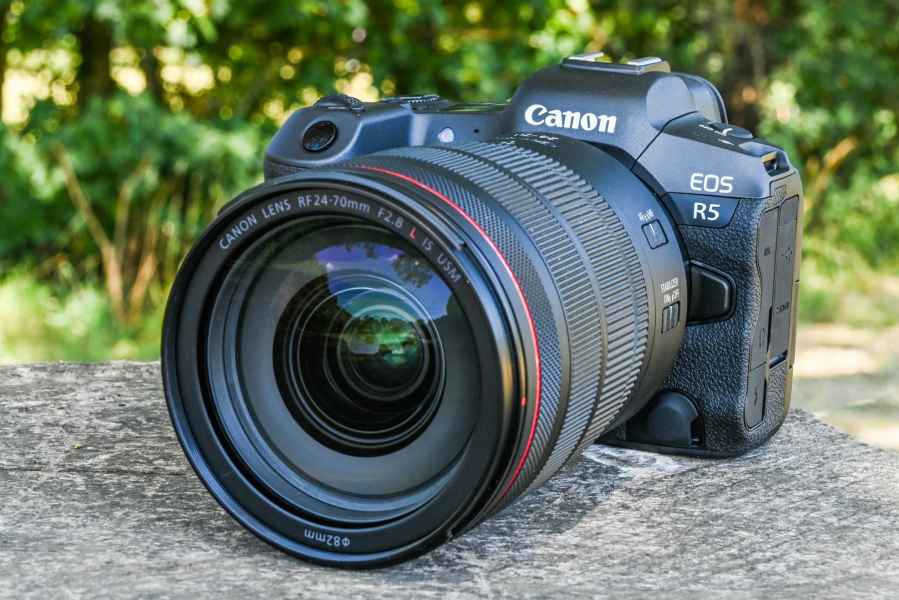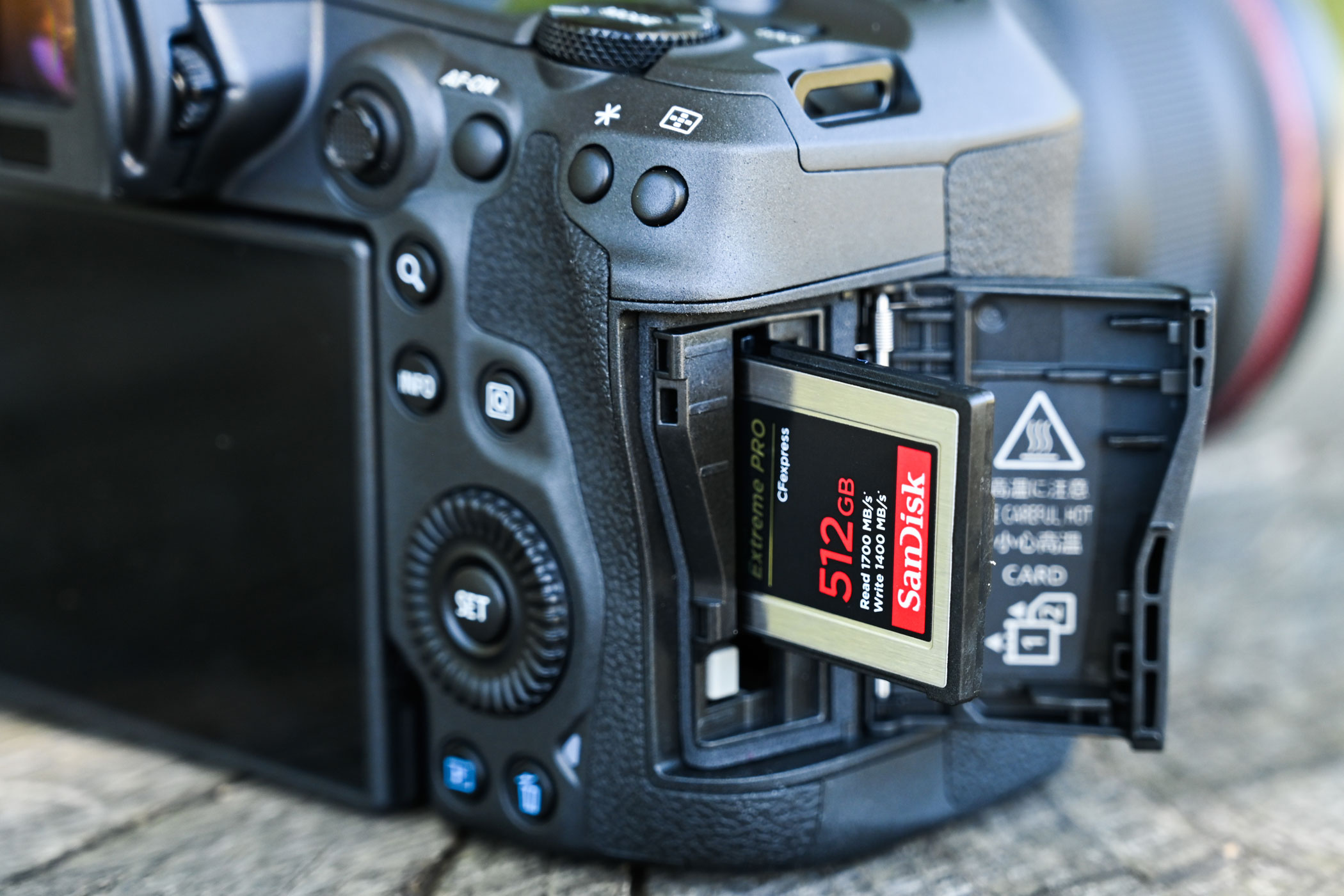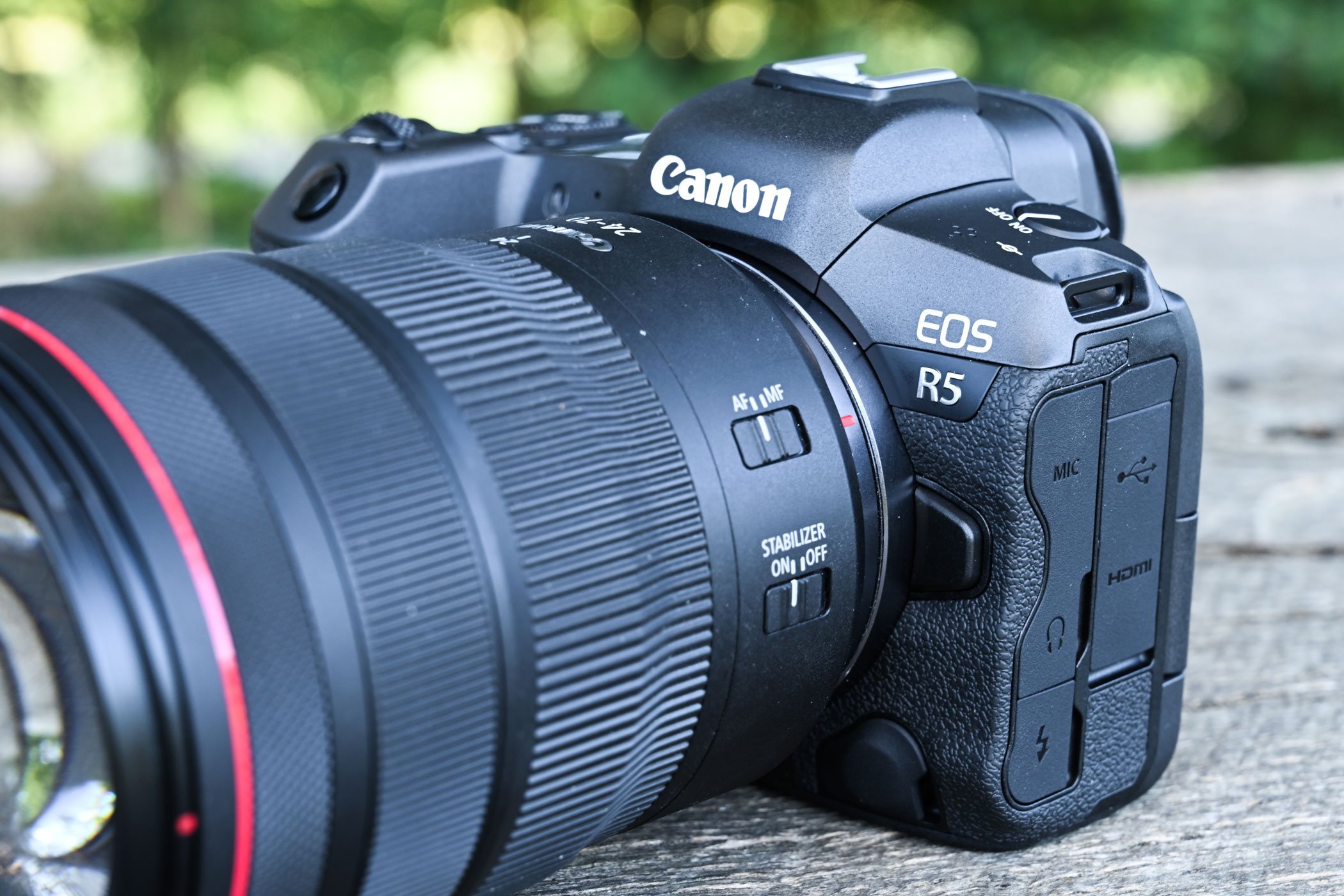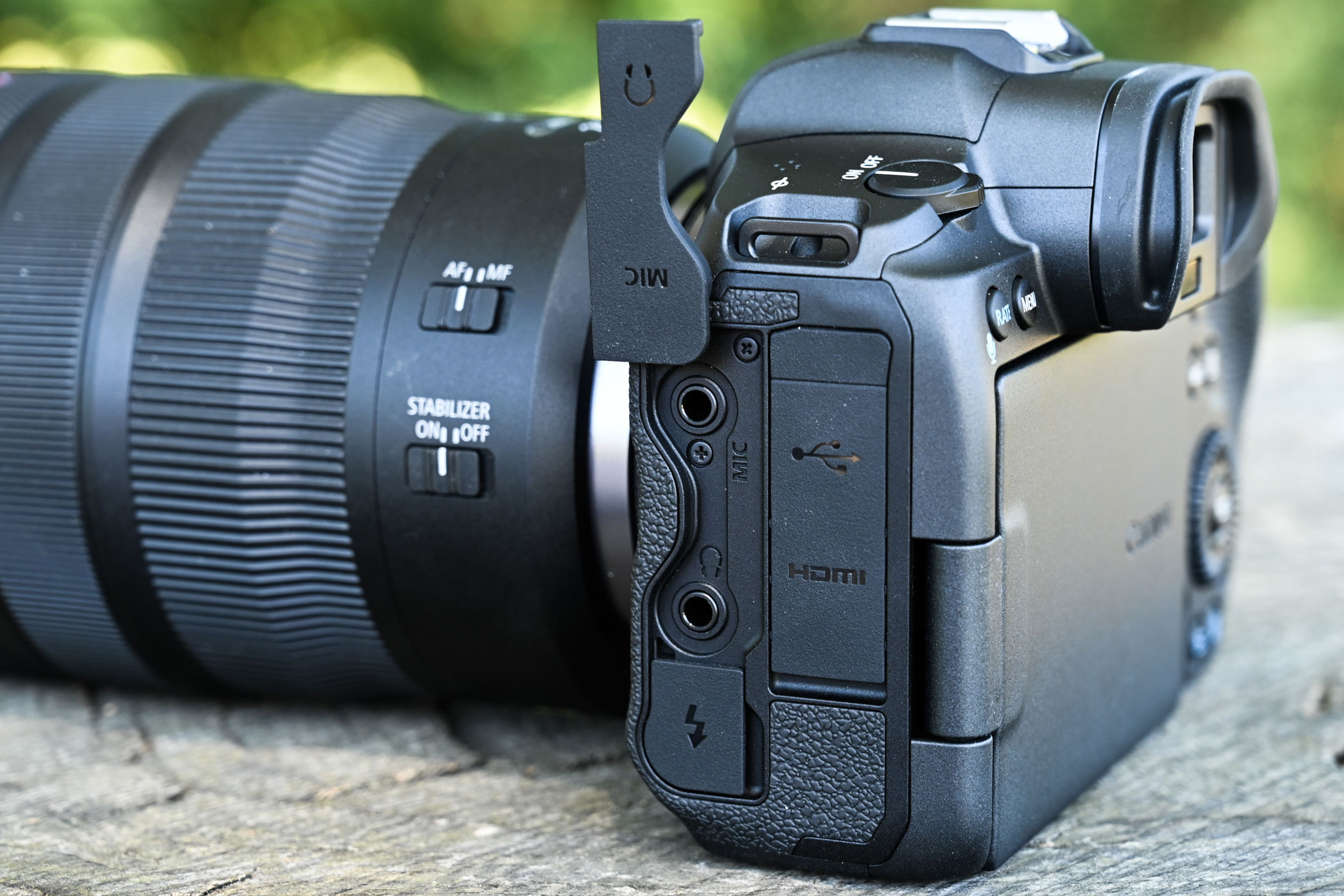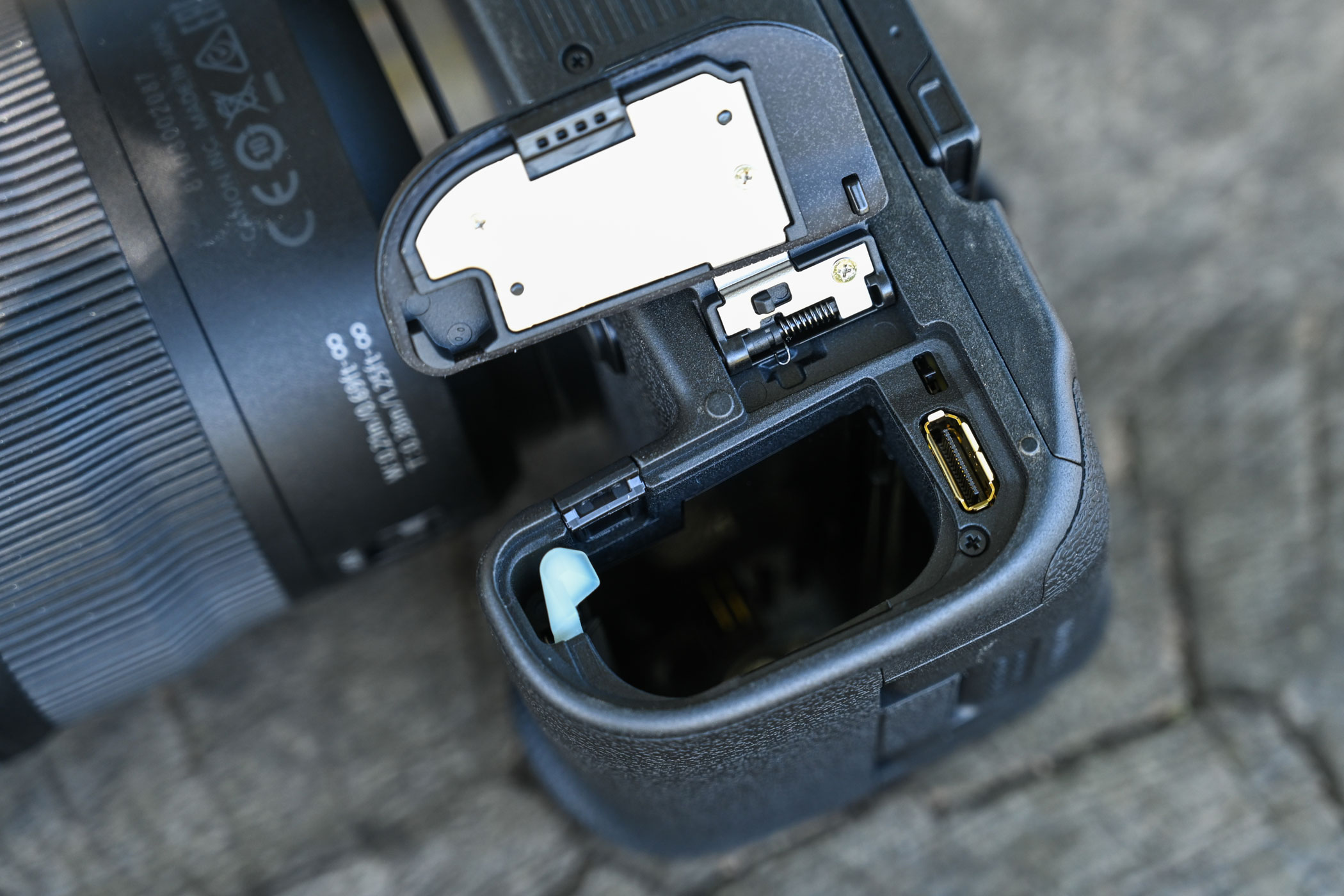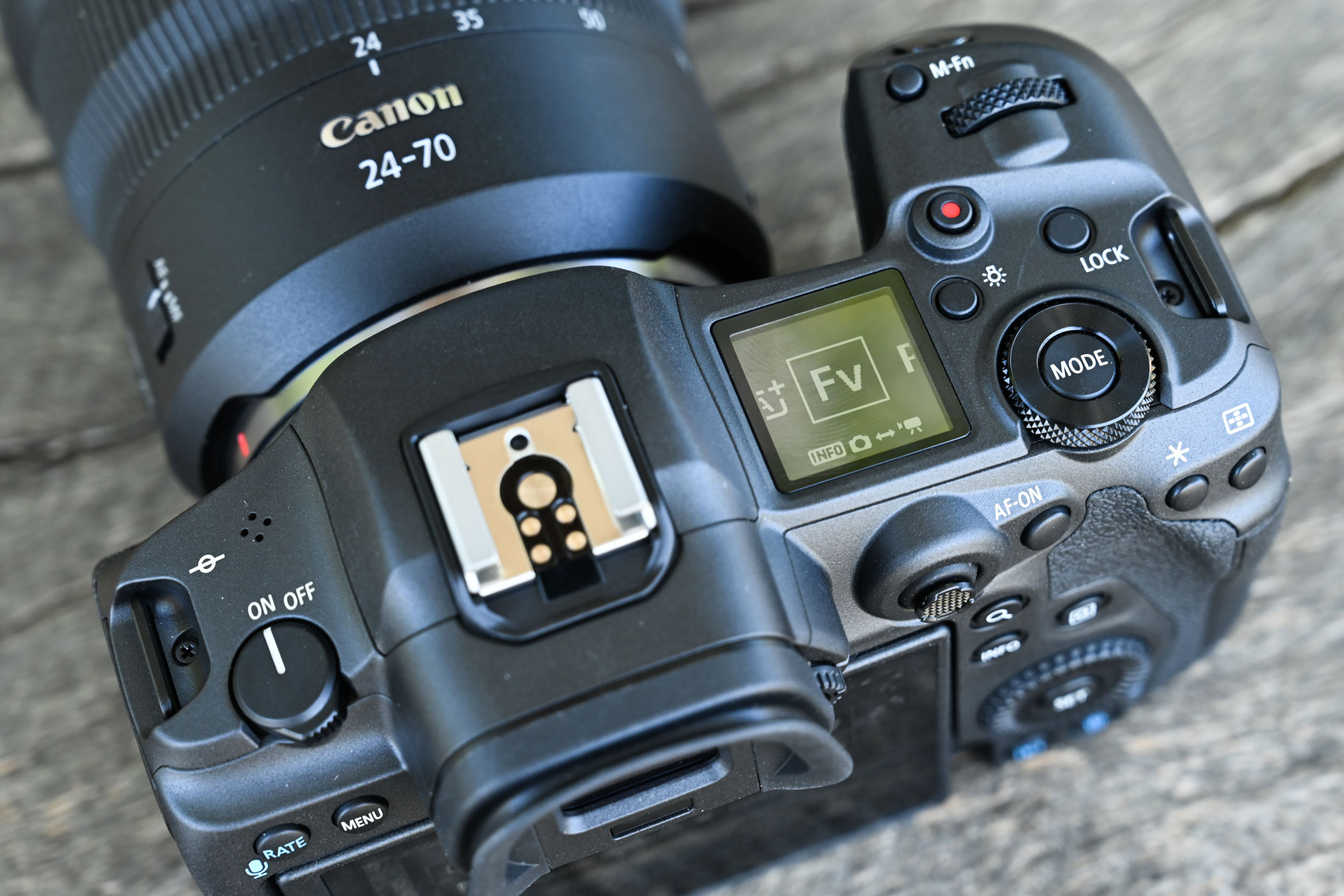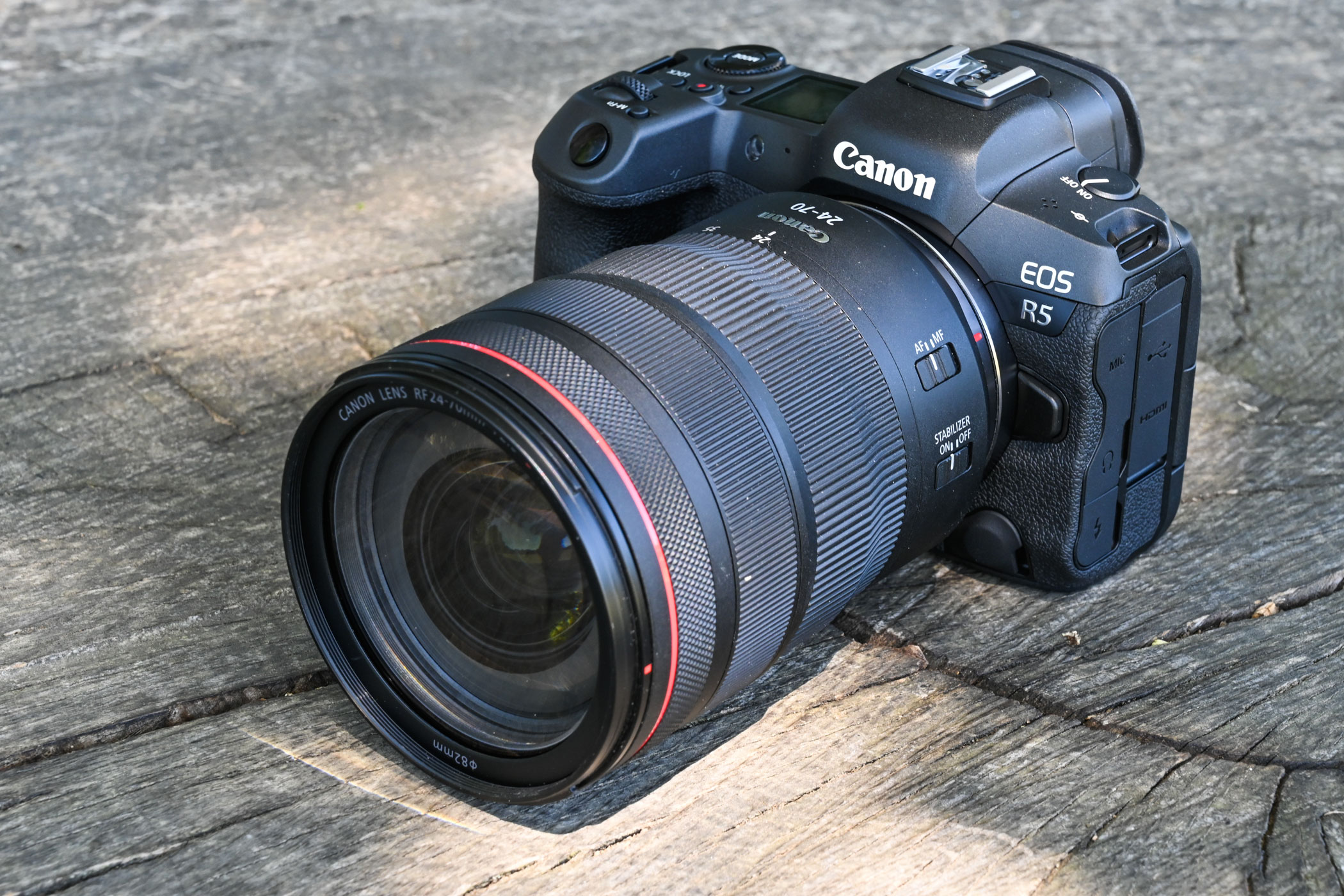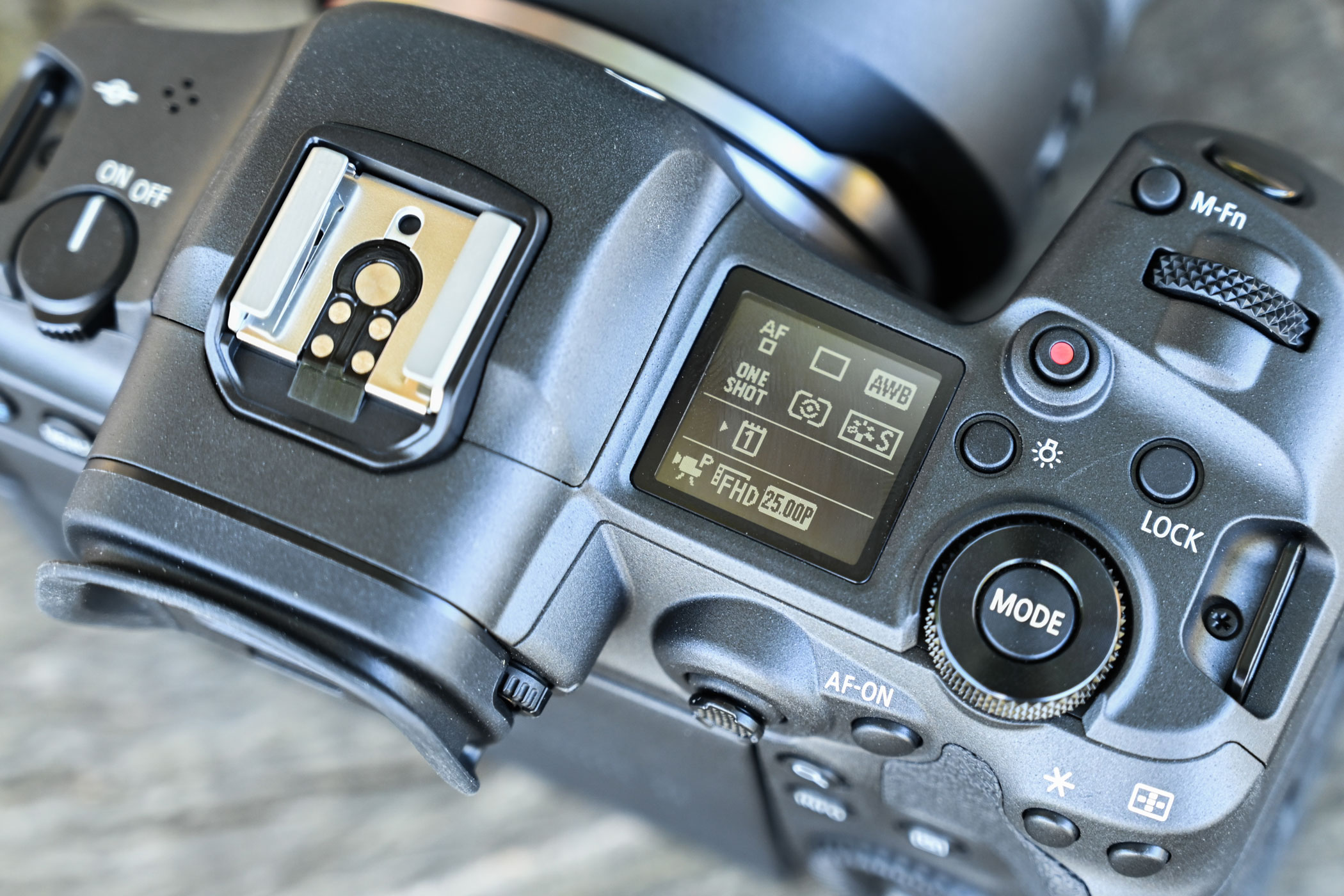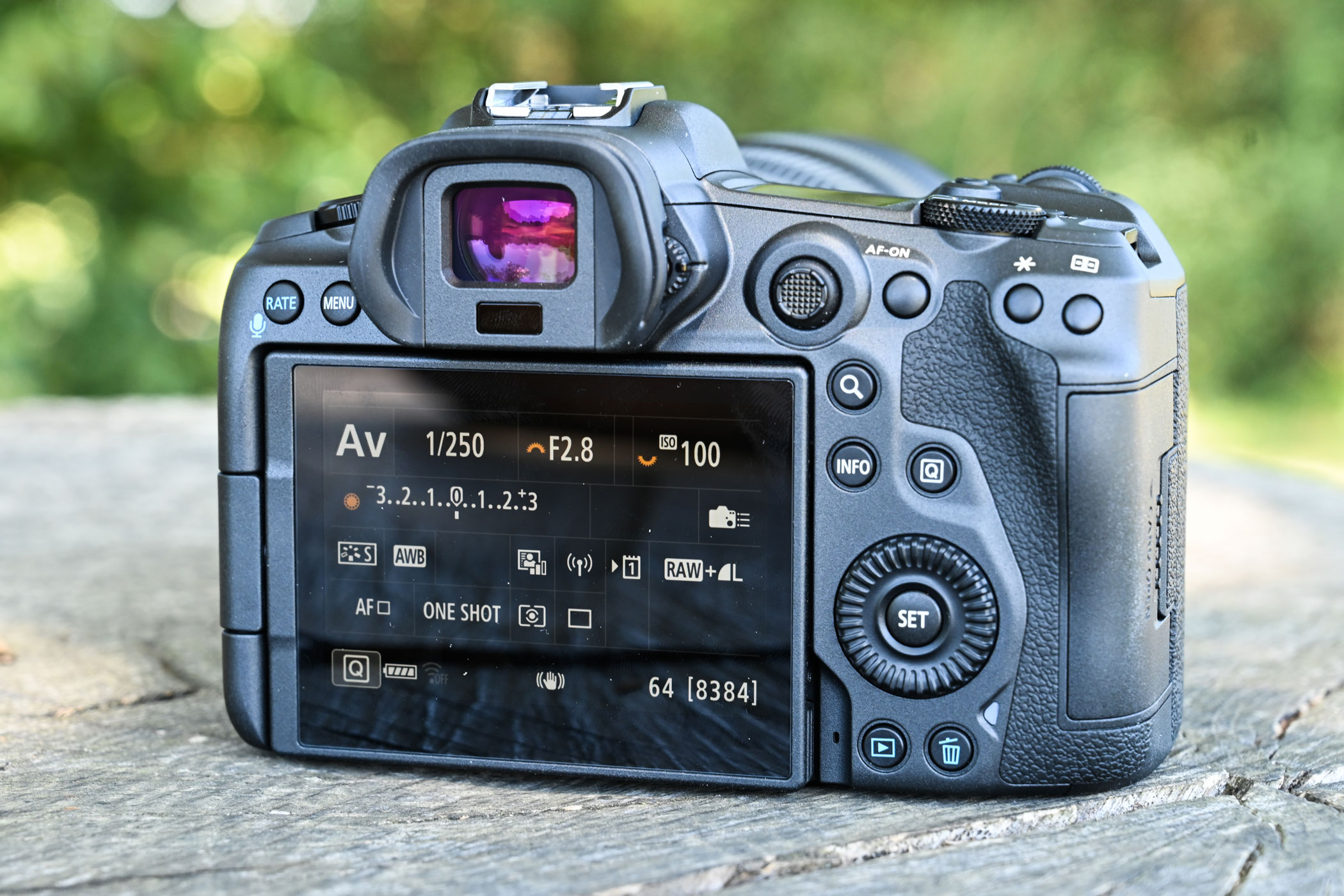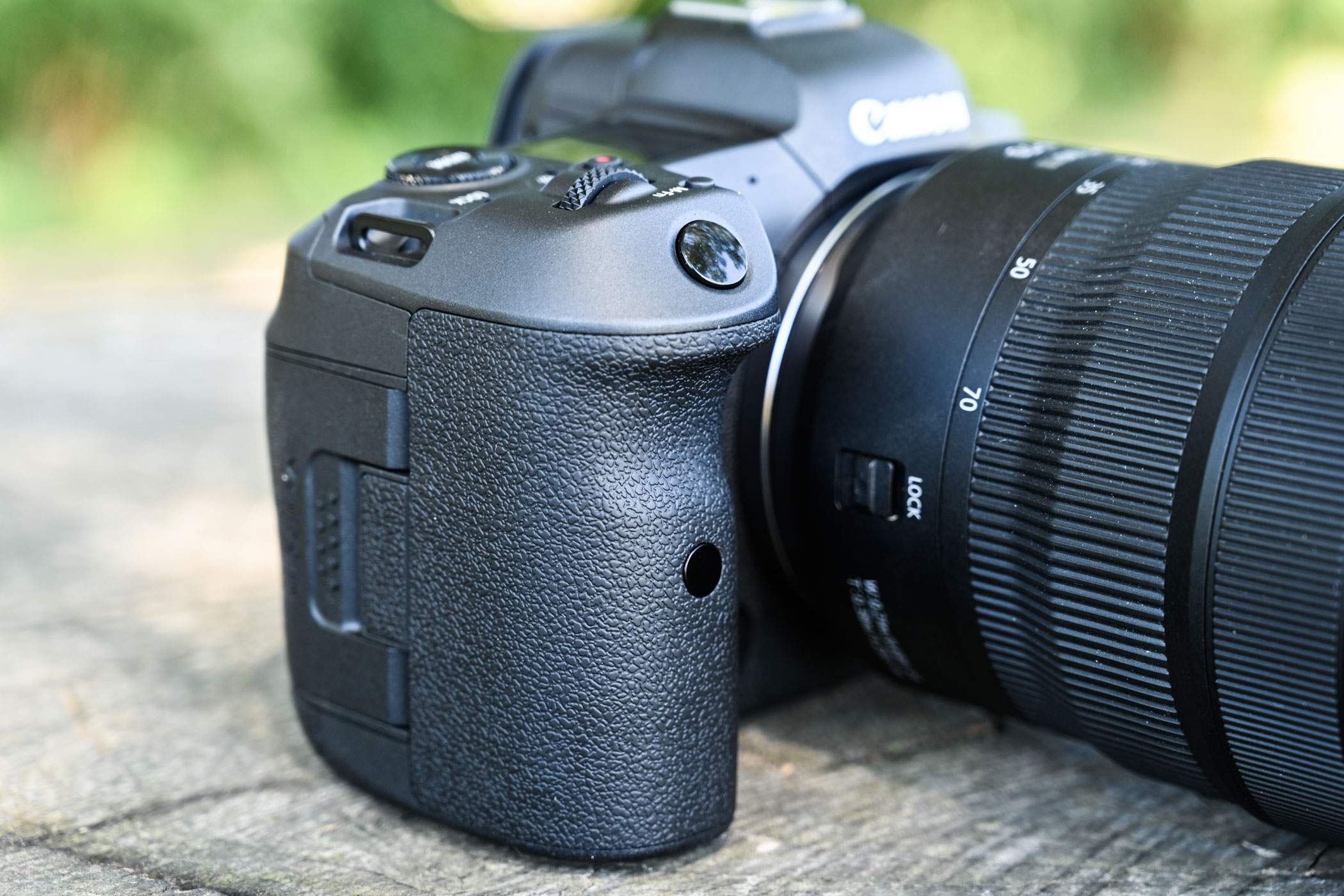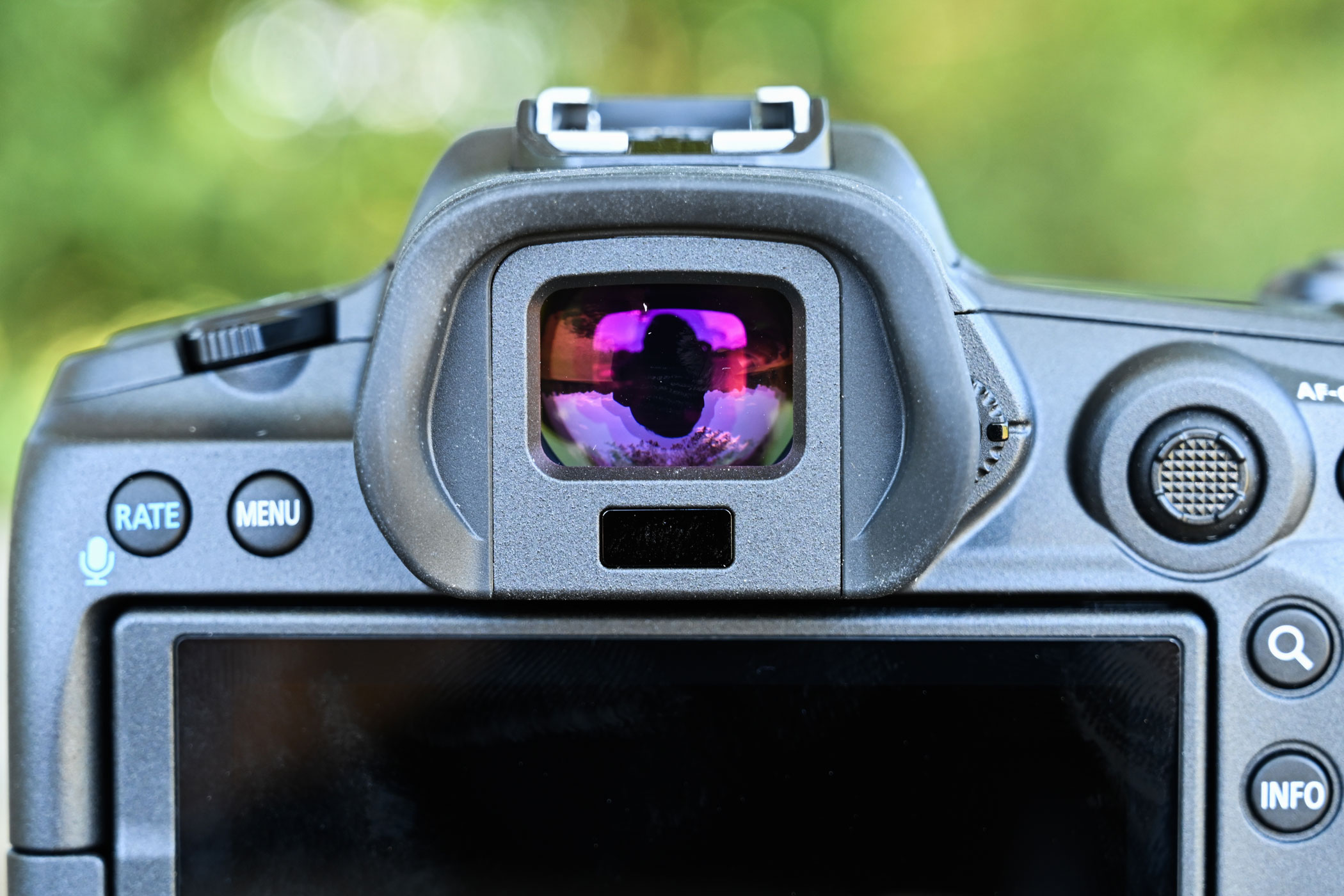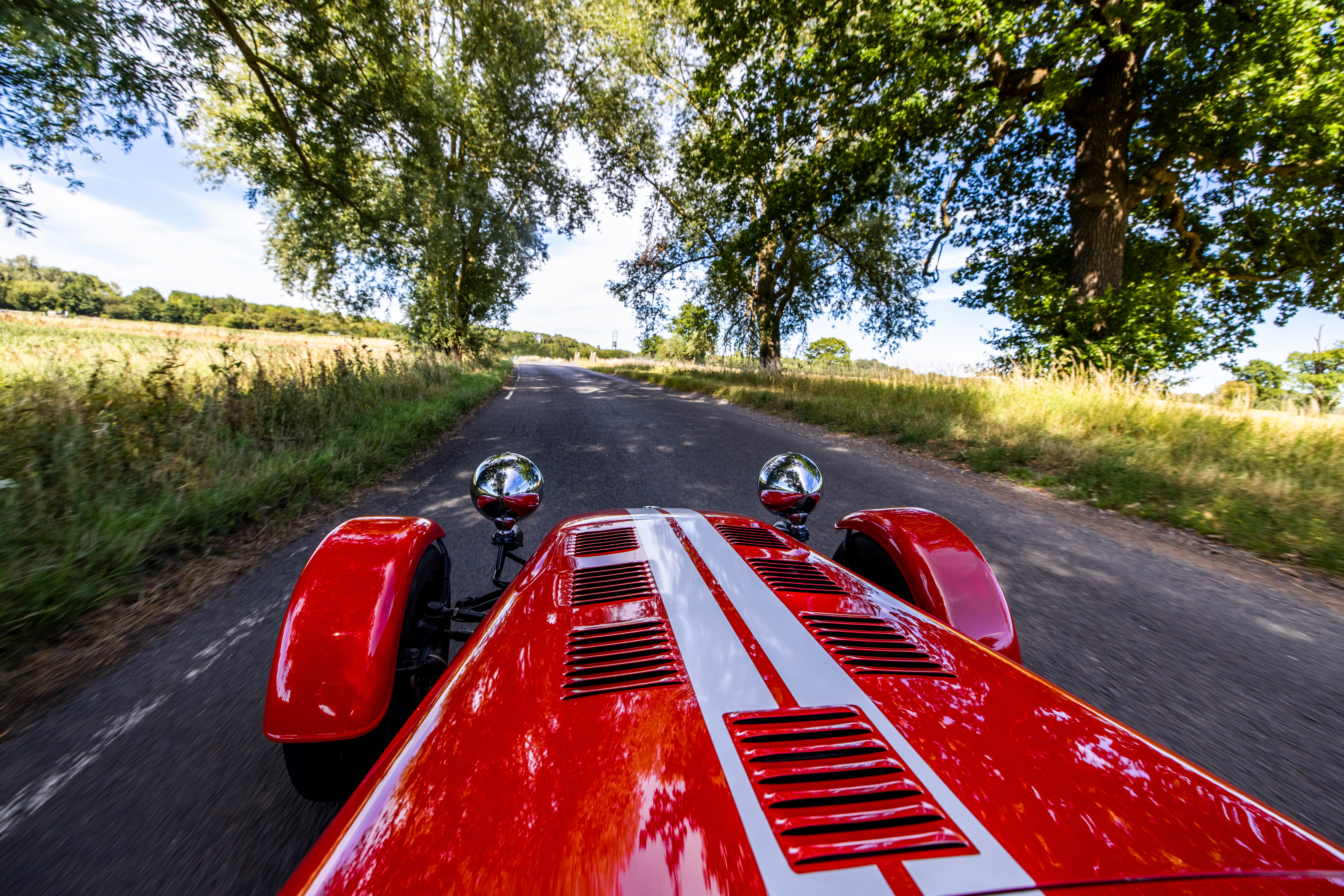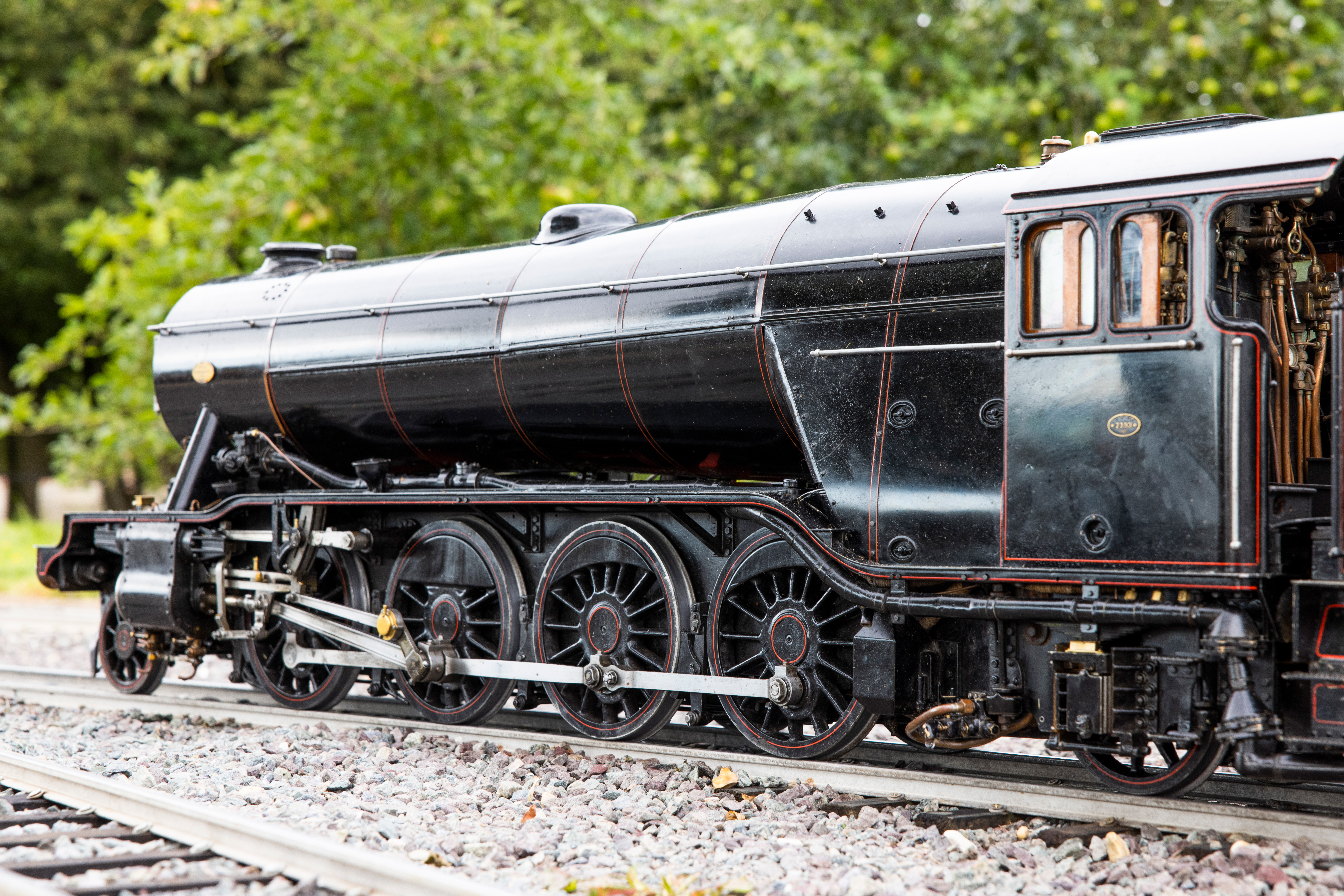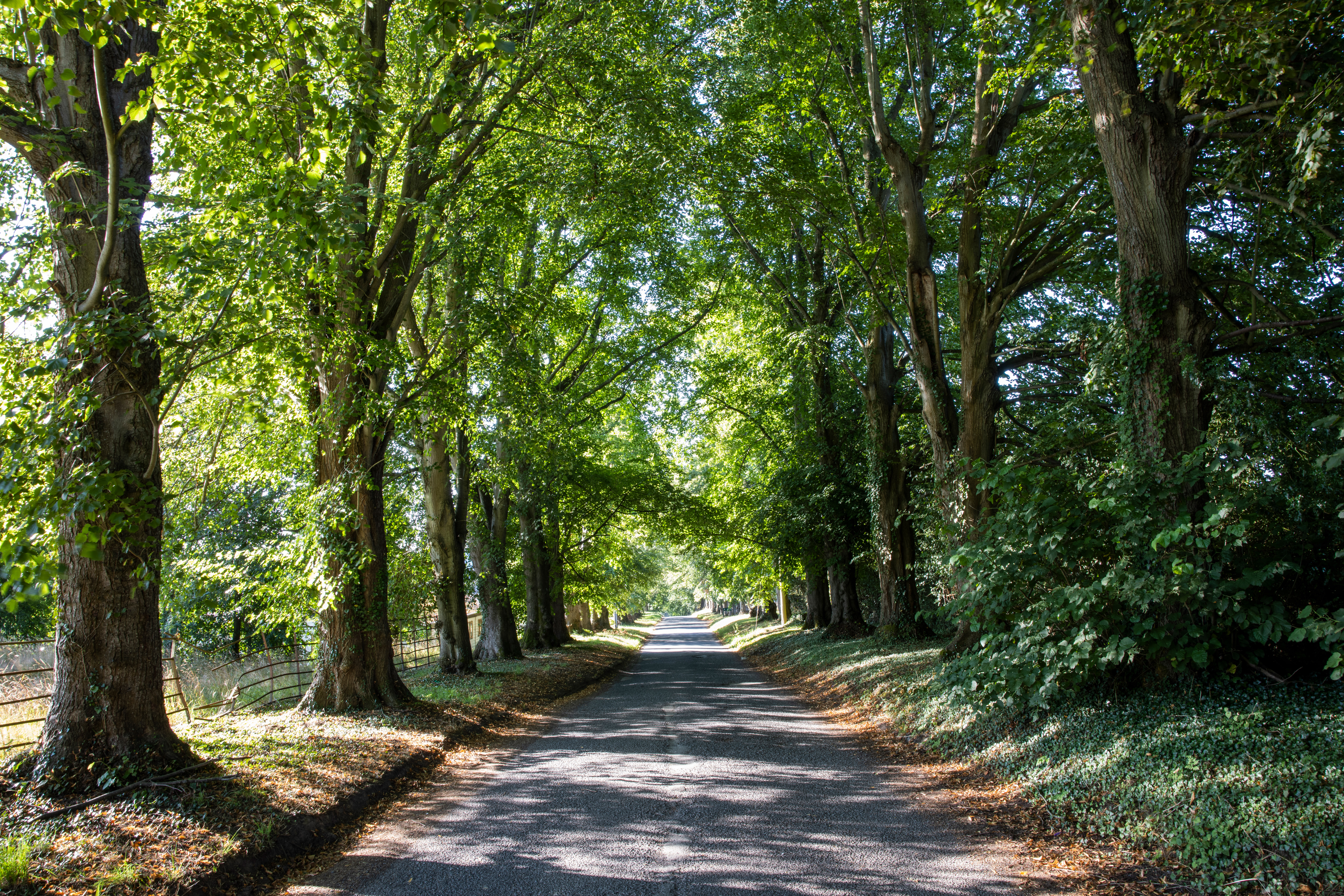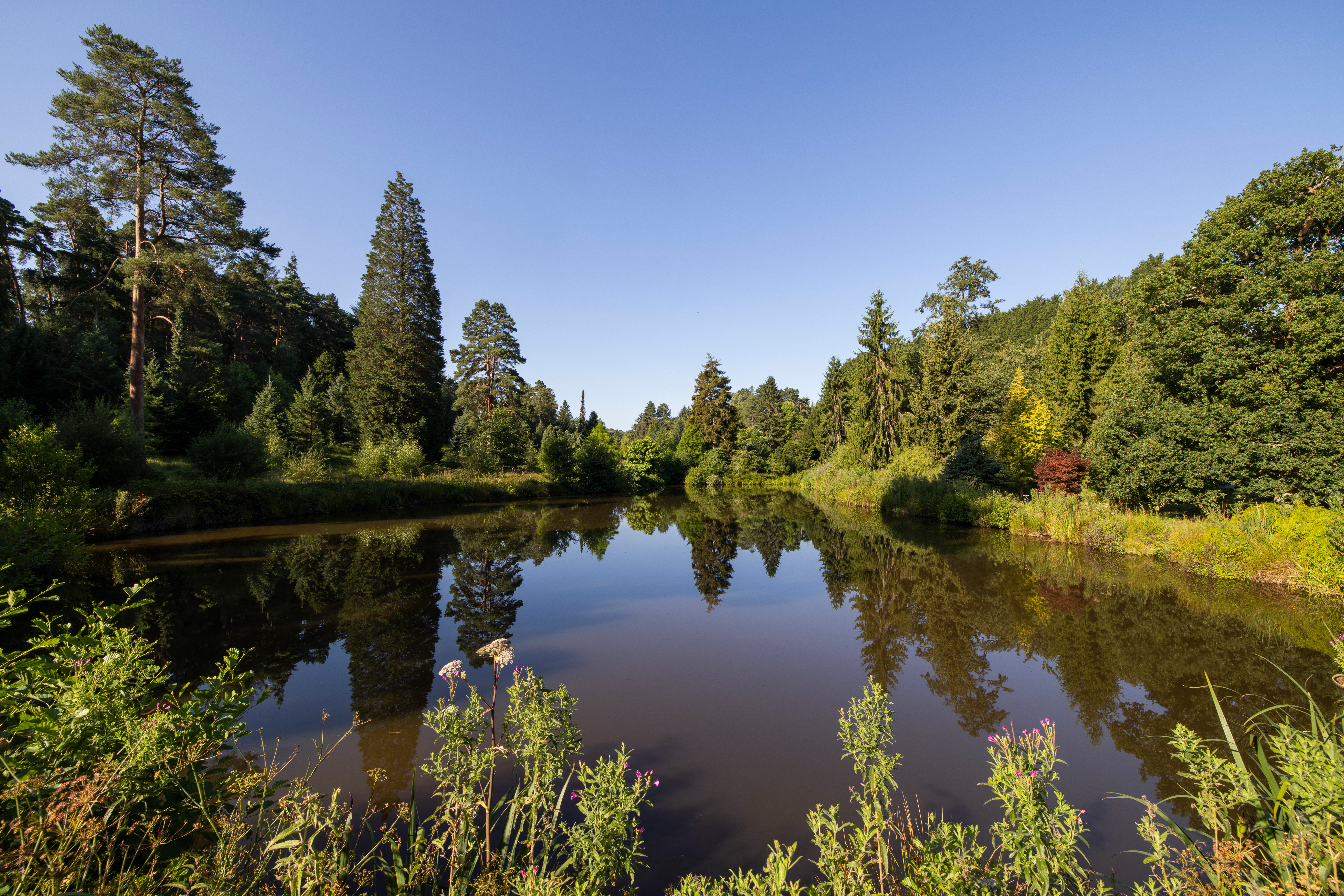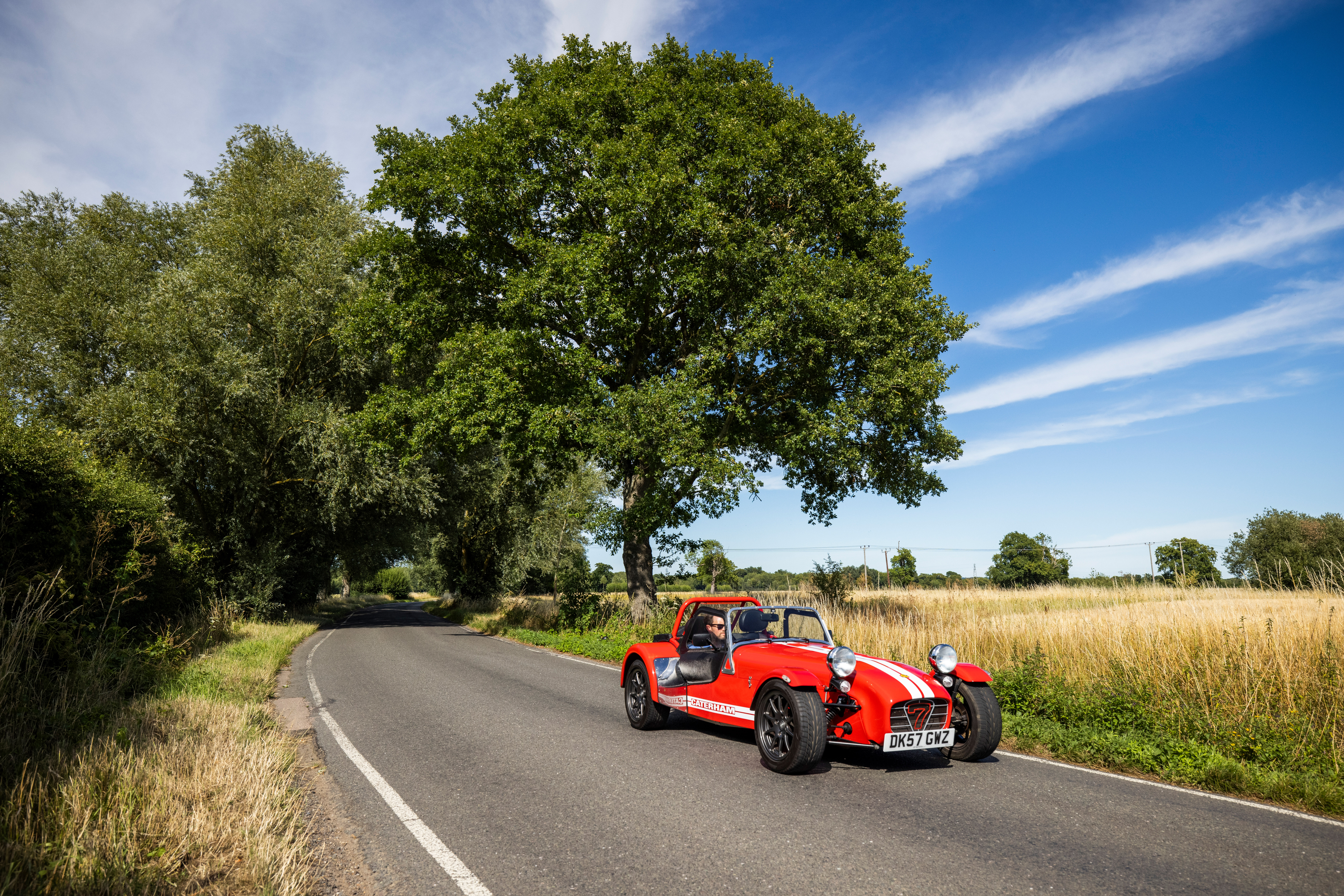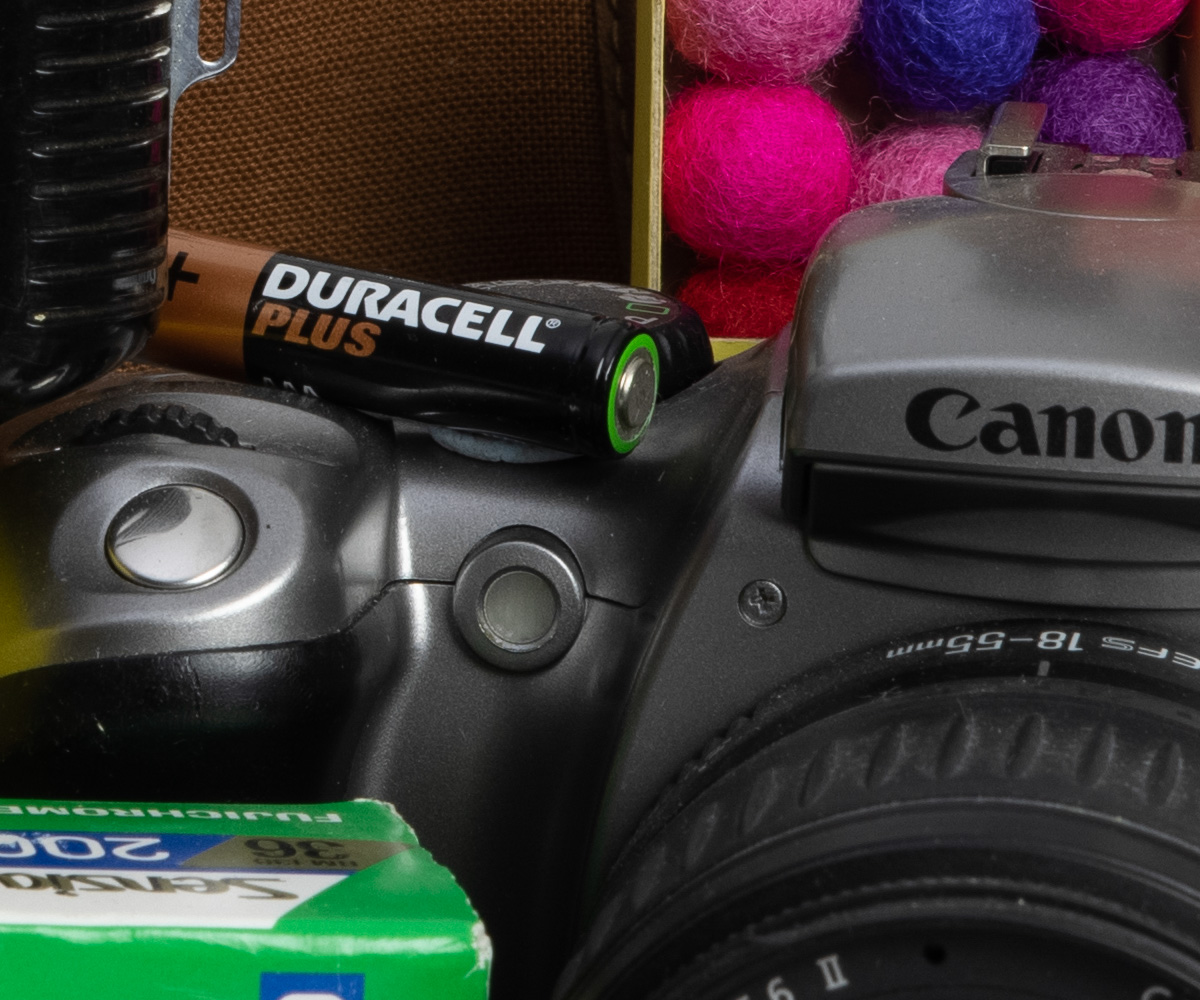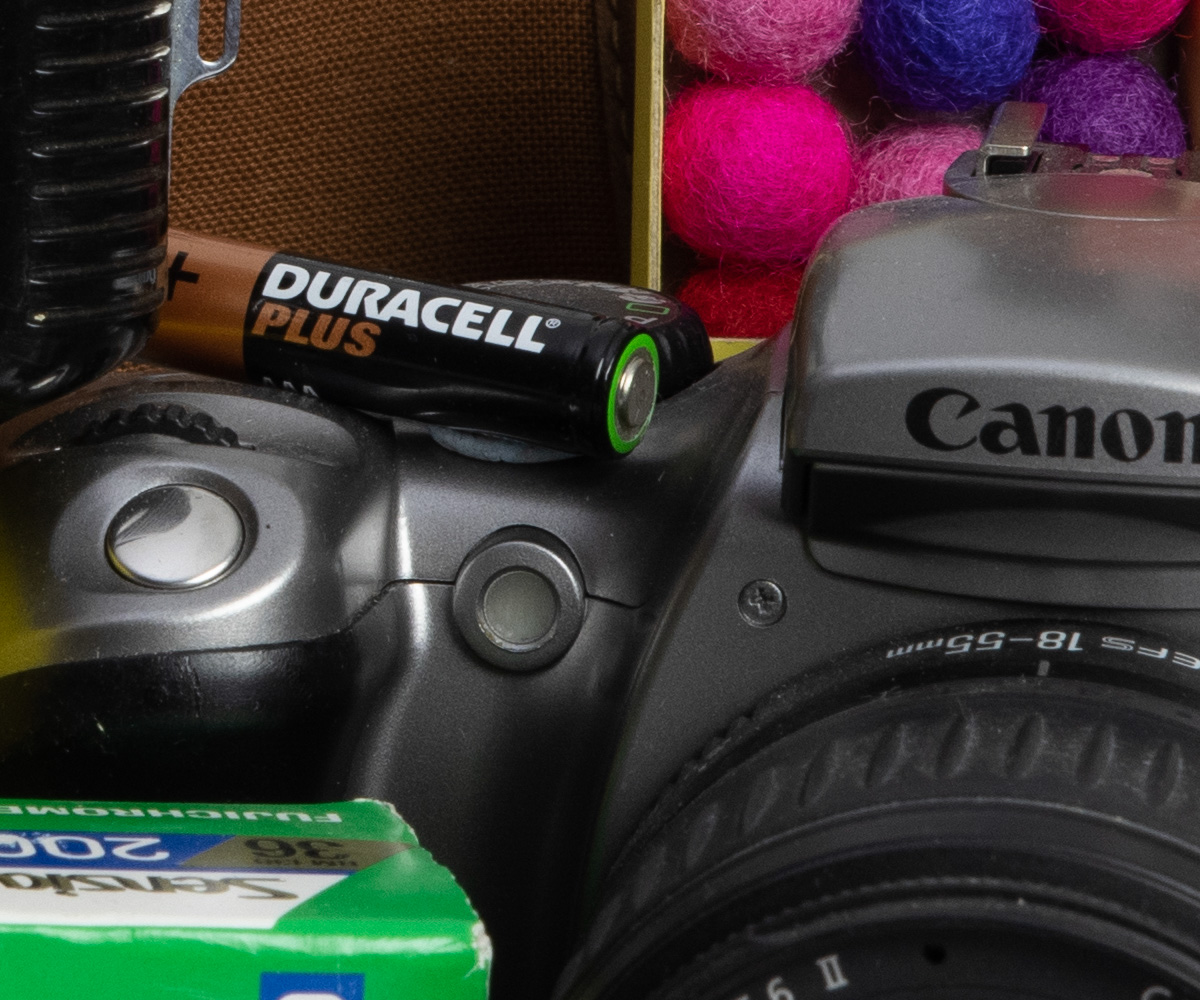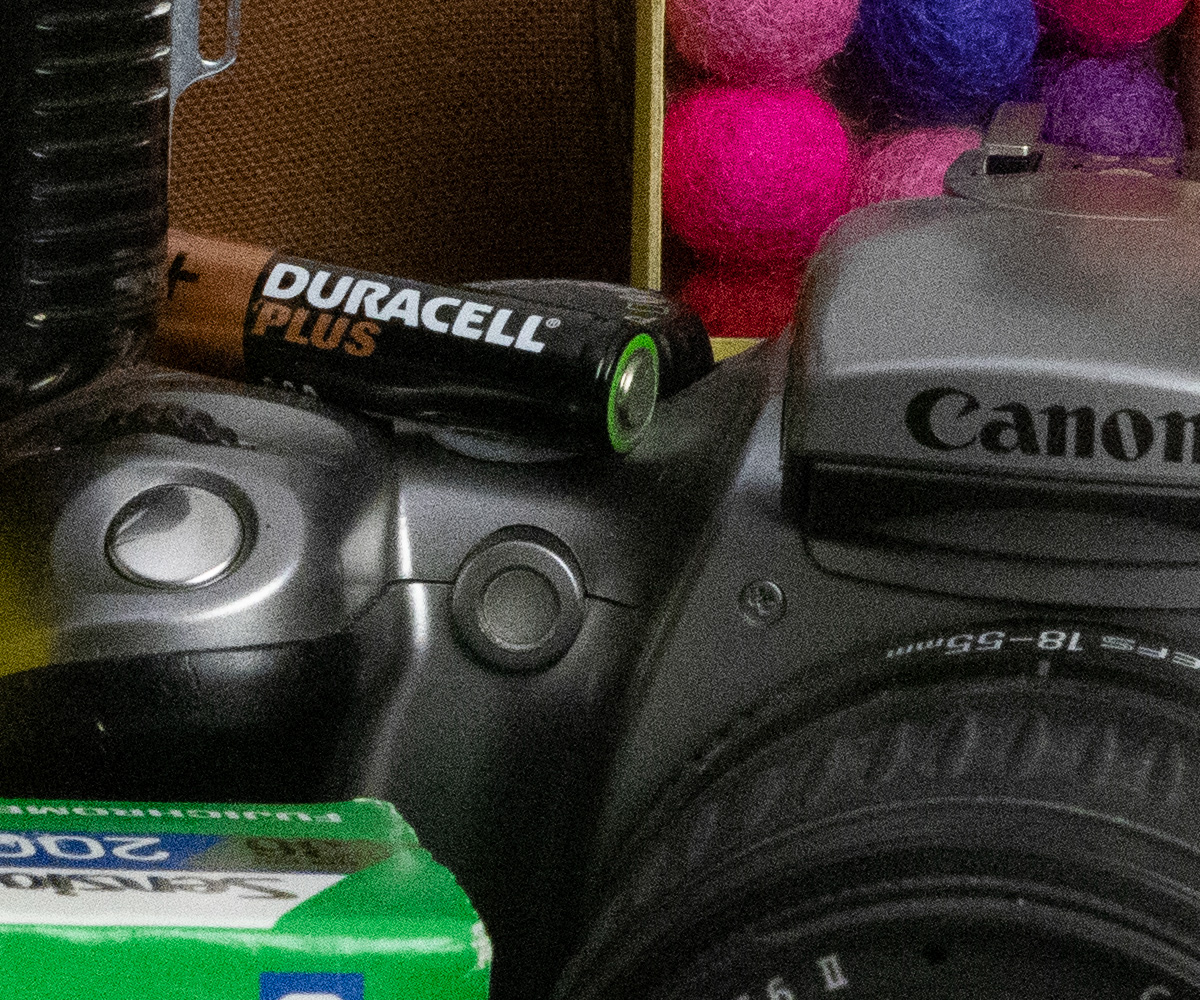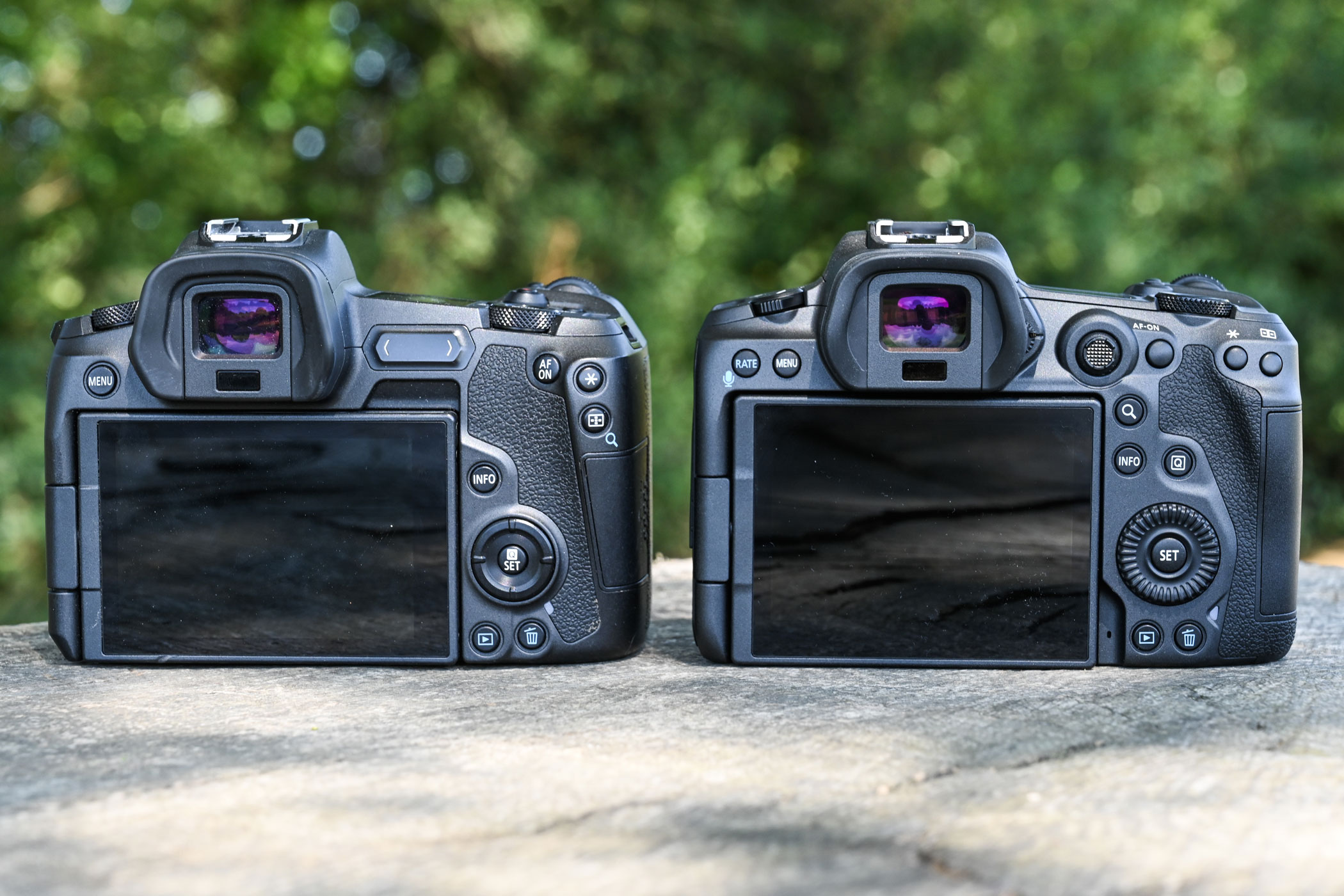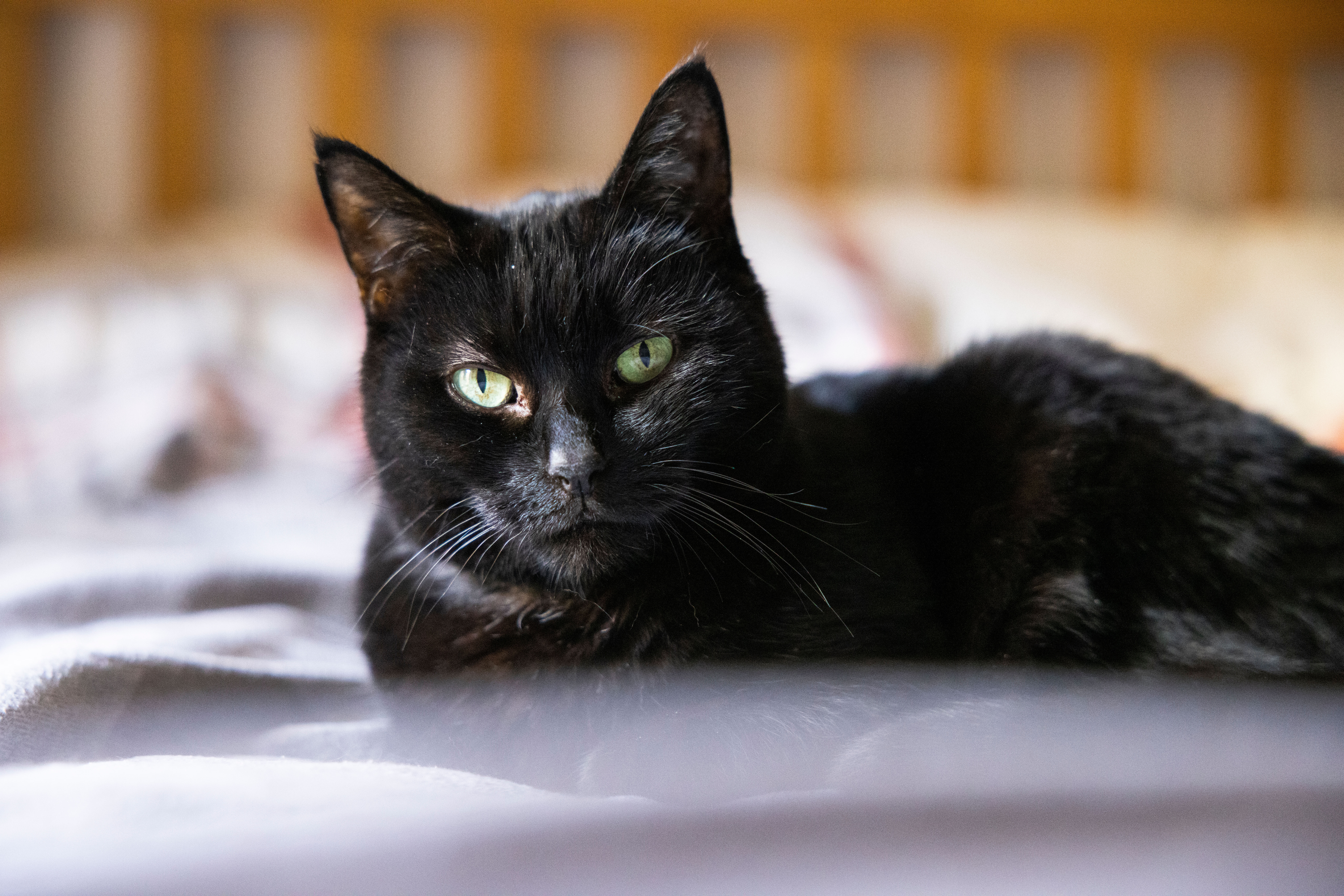Amateur Photographer verdict
The sensor and highly effective IBIS system deliver images of exquisite quality. Intuitive and a joy to use, the EOS R5 is one of the best mirrorless cameras that Canon have ever made.- Stunning electronic viewfinder performance
- Impressive video specification
- Supports use of EF/EF-S lenses via adapter
- Wonderful stills performance
- High resolution video generates heat
- CFexpress cards are expensive
- Rather power hungry
- Cost
At a glance
- 45-million-pixel Dual Pixel CMOS AF sensor
- DIGIC X image processor
- ISO 100-51,200 (expandable to ISO 50-102,400)
- 20fps continuous shooting
- 5,940 selectable autofocus positions
- 5.76-million-dot electronic viewfinder
- 8K/30P, 4K/120p, Full HD 60p video
- Twin card slot (CFexpress Type B and SD)
- $2,999 / £3,149 body-only
- Canon.com
The Canon EOS R5 was Canon’s top-dog in terms of high-end Canon cameras, but now it’s getting older, does it still justify the purchase? Find out in our full review.
Both the R and RP proved to be capable cameras but, as far as serious enthusiasts and professionals were concerned, lagged behind their rivals, notably from Sony. Canon had some catching up to do in the full-frame mirrorless race. It needed a camera with better ergonomics that could exploit the full potential of the company’s superb RF-mount lenses.
The answer came in mid-2020 in the form of the EOS R5. This was a top-end model, Canon designed it with a feature set to appeal to the demands of stills and video photographers. It launched at $3,899 / £4,199 body only. Following the release of the new EOS R5 Mark II, the EOS R5’s price is now around $3,000 / £3,100, making it a tempting option for those looking for a serious Canon camera.
Features
The EOS R5 sits above the EOS R6 Canon announced at the same time. Its replacement the Canon EOS R6 Mark II announced back in November 2022. It was the third EOS R series camera built around Canon’s RF lens mount that has a 54mm internal diameter, 20mm flange distance and 12-pin data connection.
Directly behind this mount lies a 45-million-pixel full-frame Dual Pixel CMOS sensor that Canon had never used before. It also employs an optical low-pass filter to suppress moiré and aliasing artefacts. By pairing it with Canon’s latest DIGIC X image processor, users get an ISO range of 100-51,200 (expandable to 50-102,400).
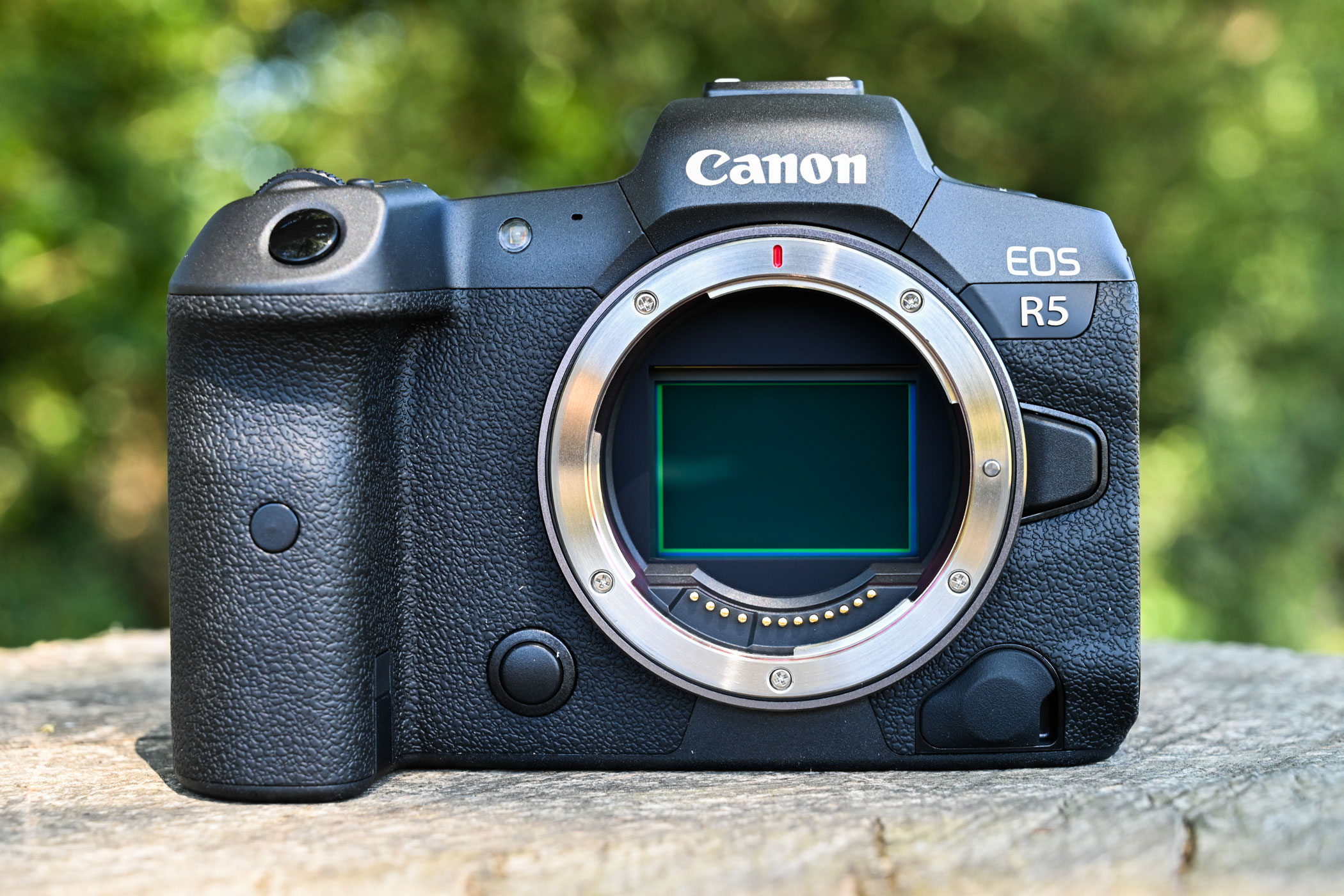
First, its impressive stills capabilities. High among these is its ability to shoot 45MP files at a staggering 20fps in silence with full AE and AF tracking using its electronic shutter. Switch over to the mechanical shutter and the EOS R5 rattles out a burst at a brisk 12fps. It’s faster than its Sony Alpha 7R IV and Nikon Z 7 rivals.
It has a deep buffer to handle the high volumes of data. Also, it records to a CFexpress B card that allows you to transfer at speeds of up to 1.97GB per second and record up to 180 uncompressed Raw files continuously at 20fps. A second UHS-II compatible SD card slot is added for backup purposes, or separating still images and video between cards.
A breakthrough on the EOS R5 was the introduction of in-body image stabilisation (IBIS). IBIS was lacking on both the EOS R and EOS RP. Canon claims up to 8 stops effectiveness when paired with certain RF mount lenses, such as the RF 24-70mm F2.8 L and RF 28-70mm F2 L. When you use the EOS R5 with Canon lenses featuring optical image stabilisation (IS), the lens corrects yaw and pitch. The body also compensates for roll around the lens axis, along with vertical and lateral movements.
See our guide to the best Canon RF mount lenses.
The EOS R5’s autofocus system can focus down to an impressive -6EV in low-light. As a result, it can focus with maximum apertures as small as f/22. This also allows you to use teleconverters with relatively small-aperture lenses, compact super telephoto lenses like the RF 600mm F11 IS STM, RF 800mm F11 IS STM and the new RF 200-800mm F6.3-9 IS USM.
Focus acquisition occurs as fast as 0.05sec. There are 5,940 selectable AF points covering 98% of the image area, and it inherits Canon’s powerful subject recognition and deep-learning AI technology from the EOS-1D X Mark III.
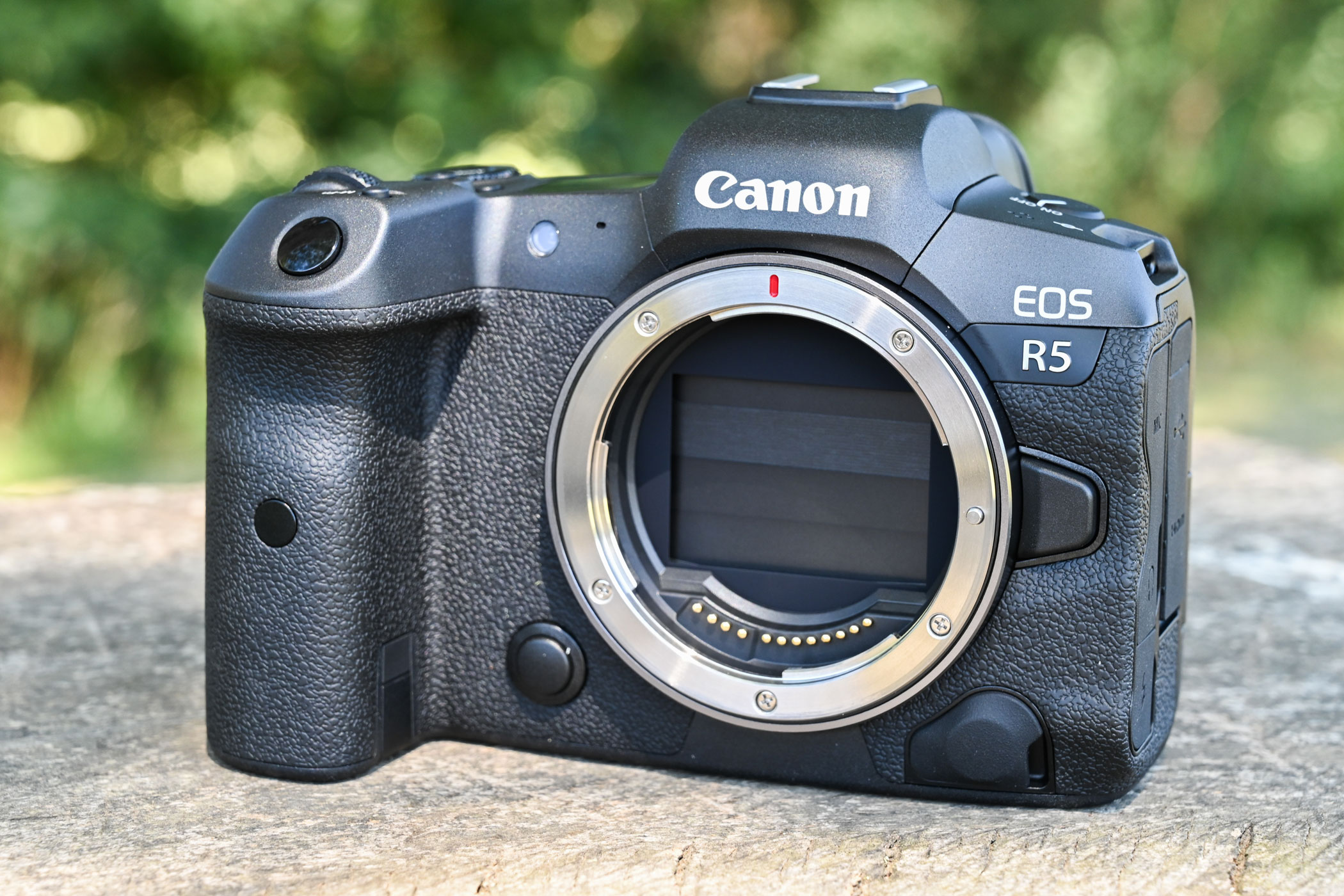
At launch, Canon programmed the camera to recognise and track humans, cats, dogs and birds. It extended this with a firmware update to include vehicles (racing cars or motor bikes). Face and eye detection has also been improved to recognise faces more accurately.
You get all the usual predefined Servo AF case sensitivity settings, so you can adjust the focus tracking sensitivity and acceleration/deceleration tracking. Additionally, the EOS R5 introduces a Case A (Auto) setting intelligent enough to automatically select one of the four subject-specific AF cases in response to changes in subject movement.
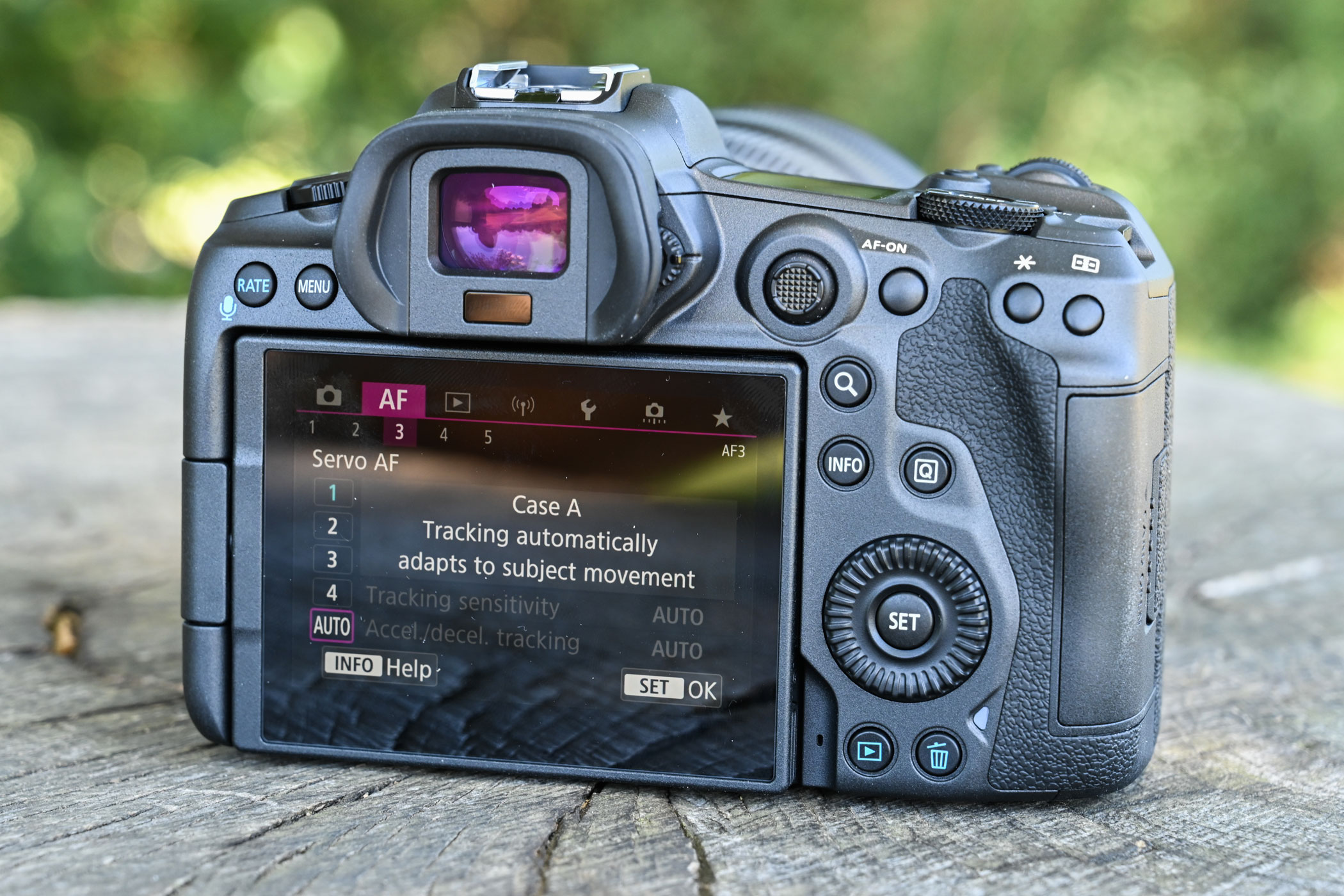
The EOS R5’s video spec is remarkable on paper. It’s the first mirrorless camera capable of recording DCI 8K (8192×4320 pixel) or UHD 8K (7680×4320) raw video internally using the full width of the sensor at up to 30fps. The high data throughput demands you use a CFexpress card when shooting in 8K (unless you use IPB compression). There is also the option to grab 35.4MP JPEG still images at the same time.
There’s a plethora of bit depth and compression options in the video menu. Options include broadcast quality 4:2:2 10-bit output and Canon Log to produce footage with extra-wide dynamic range and generous exposure latitude for easy colour grading in post production.
Meanwhile, 4K video is available in DCI (4096×2160) and UHD (3840×2160) resolutions at frame rates up to 120p for silky-smooth slow-motion capture. At frame rates up to 60fps, there is a choice between recording 4K video using the full width of the camera’s sensor or a 1.6x crop.
Video users who demand the highest quality 4K footage may also want to use the 4K HQ mode that reproduces exquisite detail at frame rates up to 30p by oversampling 8K footage. If that wasn’t enough, the EOS R5 supports Full HD video at up to 120p.
Canon’s website has detailed information about heat build-up and explains how this limits record time. However, since its launch the EOS R5 has enjoyed several firmware updates to ameliorate this. In v1.60, longer video recording times were possible with the Auto Power Off Temperature option. Selecting High means the camera will not automatically shut-down when it gets warm, depending on the conditions. The latest firmware is v1.9.0, which added voice memo functionality and bug fixes. Meanwhile, v1.8.1 brought a High Resolution shot mode, although output was JPEG only.

Regarding connectivity, the EOS R5 includes Bluetooth and Wi-Fi. With the Canon Camera Connect app for Android or iOS, you can use your smartphone as either a Bluetooth wireless release, or a comprehensive Wi-Fi remote control complete with a live view feed and the ability to change a wide range of settings. If you’d prefer to plug in a wired release, the EOS R5 is equipped with an N3-type remote release connector at the front. It also has an infrared remote receiver on the handgrip.
Focal Points
Here, we take a look at some other exciting features we’re yet to mention.
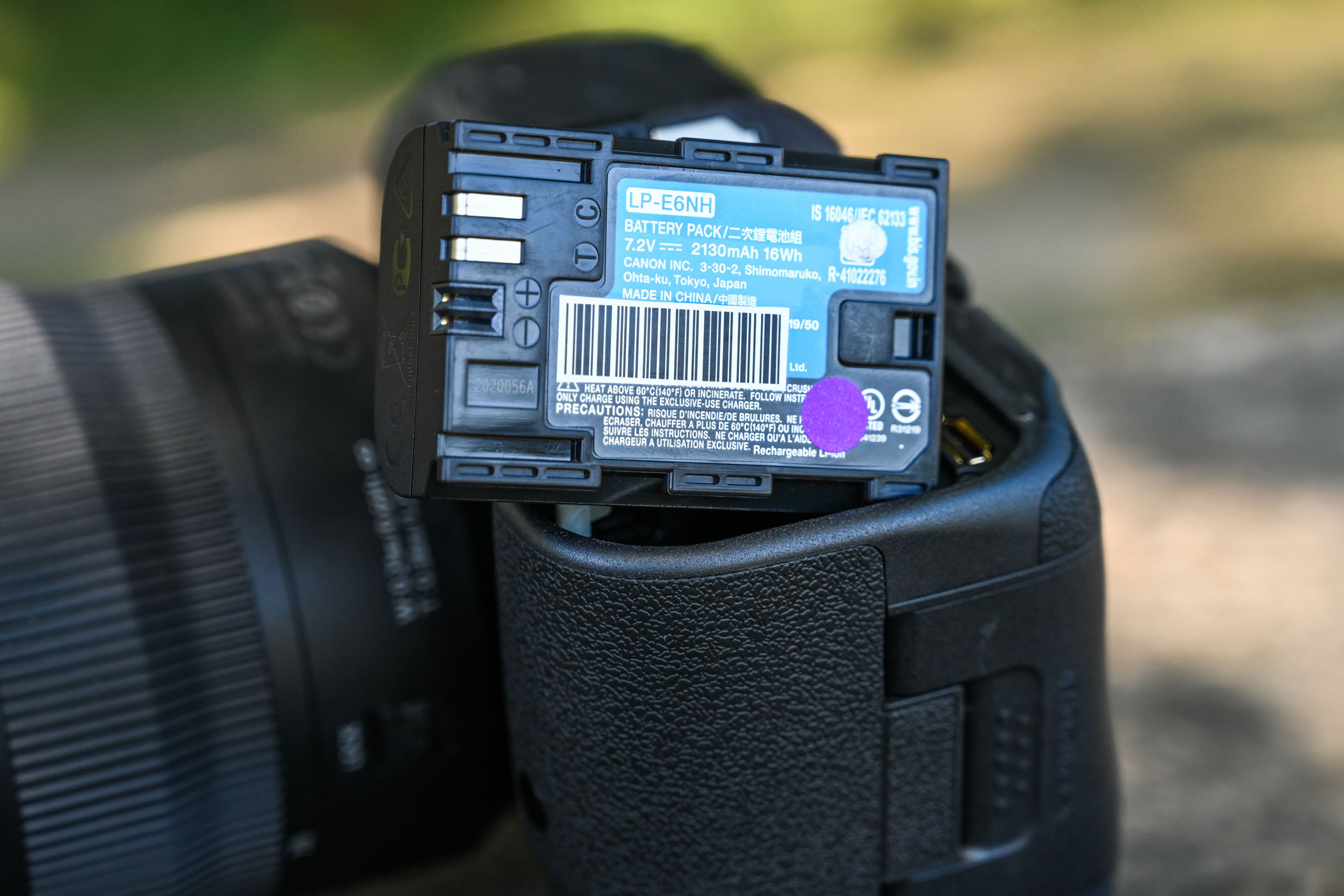
Time Lapse: You can capture high-resolution time-lapses in 8K and 4K resolutions, with the movie created in camera. You can also specify the time between each frame, and choose to lock exposure at the start of the sequence or re-meter for every shot.
Focusing aids: The EOS R5 offers tools to help you nail critical sharpness when focusing manually. Focus peaking highlights the edges of in-focus objects with your choice of colour, while Dual Pixel Focus Guide uses a graphical indicator to display whether the subject is front/back focused and turns green when correct focus is achieved.
FTP: Professional photographers who want to deliver photos directly to clients quickly and securely from their current location can use the camera’s built-in Wi-Fi. You can configure FTP settings in-camera or off-line using EOS Utility software. Plus, you can save up to 10 presets for instant recall.
Dual Pixel Raw: Canon’s Digital Photo Professional (DPP) software takes control of image micro adjustment, bokeh shift and reduces flare and ghosting. In portraits, you can now adjust lighting on people’s faces in-camera when dual pixel raw mode is activated. It will allow you to alter the clarity of hazy backgrounds, too
Battery compatibility: You can use the EOS R5 with the older type of LP-E6 and LP-E6N batteries. It’s worth noting, however, that the fastest shooting speeds and in-camera charging is not available when using the LP-E6 battery.
Fv mode: Canon’s Flexible-priority AE mode is similar to Program AE mode. The difference is it allows you to take instant control of ISO, shutter speed, aperture and exposure compensation when required. The rear dial toggles between these variables and the top dial adjusts the setting. Underlined settings indicate that the camera is controlling them automatically.
Interface: At the side, there is a USB 3.1 connector you can use to charge the new LP-E6NH battery, which is rated for 320 shots using the EVF, or 490 with the LCD. Beside this is an HDMI micro out (Type D) interface. A PC-sync flash port is also provided.
High Resolution Shot mode: This feature came with firmware v1.8.1. It uses the camera’s IBIS system to produce pictures of static scenes with a higher resolution. The camera makes nine separate exposures, with the sensor moving slightly between each shot. These shots are merged in-camera to give a 400MP equivalent JPEG. Sadly, you don’t get the individual files to play with afterwards, so there’s still room for Canon to refine this feature.
IBIS Effectiveness
At launch, there were ten Canon RF lenses that gained between 6.5 and 8 stops of stabilisation. Of course, Canon have added more lenses since then; as of mid 2023, there were 18 primes and 14 RF lenses.
The Canon RF 24-70mm F2.8L IS USM, Canon RF 24-105mm F4L IS USM, RF 24-105mm F4-7.1 IS STM, Canon RF 28-70mm F/2L USM and RF 70-200mm F2.8L IS USM, all benefit from a maximum of 8 stops of image stabilisation.
Meanwhile, the RF 15-35mm F2.8L IS USM, RF 35mm F1.8 IS USM and RF 50mm F1.2L USM benefit from 7 stops of image stabilisation. Pair the Canon RF 24-240mm F4-6.3 IS USM or RF 100-500mm F4.5-7.1L IS USM with the EOS R5, and you’ll get 6.5 stops and 6 stops of effective image stabilisation respectively.
Build and Handling
To tempt DSLR users and professionals, Canon had to get the build quality and ergonomics of the EOS R5 just right. It takes some getting used to the layout of buttons and dials compared to a DSLR like the Canon EOS 5D Mark IV. There’s no longer buttons down the side of the screen. No buttons are dedicated to things like ISO, drive mode and AF mode, either. The body is slightly chunkier than the Canon EOS R. However, the layout of controls on the top plate is identical.

The on/off switch is positioned on the top left shoulder and the mode dial button is located inside the rear thumb dial. Just to the left of this is a square top plate panel. It’s smaller than you get on some Canon DSLRs, but it displays all the information you need clearly. Holding down the illumination button beside it lets you darken settings against a lighter background. Alternatively, you can tap it to switch the standard view of exposure variables to an advanced one. This will display a broader overview of shooting information.
Above the illuminate button is a movie-rec button. You can gain quick access to the movie-shooting modes by hitting the mode button followed by the info button. Behind the shutter button is a small multi-function (M-Fn) button that you can customise to an assortment of functions. So can ten of the other buttons across the body. Better still; users get the option to segregate customised settings between stills and movie modes.
To access ISO, drive mode, AF mode, white balance and exposure compensation in an instant you can leave the M-Fn button set to its default Dial Function setting, selecting the setting from the rear dial and adjusting it from the front dial, or use the additional control ring found on RF lenses. For the latter, there is also the option to set the control ring so it adjusts the AF method, picture style or colour temperature, directly or while pressing the metering button.
There’s plenty more to comment on at the rear. It’s no surprise to see that the heavily scrutinised M.Fn bar that debuted on the EOS R has gone. In its place, you get a more traditional arrangement of controls. If you’ve used Canon’s pro-spec DSLRs in the past, you’ll be familiar with those.
The AF joystick, or multi controller, is positioned higher than on cameras like the EOS 5D Mark IV. Rather than moving your thumb down to control it, you find yourself shifting your thumb to the left a little from its resting position. Initially, I thought this might be a bit of a stretch. I quickly found myself adjusting to its new position, though. On the subject of the thumb rest, it has a deeper profile than the EOS R’s. As a result, the entire body feels more secure when you hold in your right hand.
The AF-ON button is conveniently positioned alongside the joystick. Also positioned within easy reach of your thumb are the exposure lock and AF point select buttons. Magnify, info and quick menu buttons are located below. It took time for my muscle memory to remember which is which without looking, however.
Another well-received control is the control wheel at the rear. Smaller than control rings found on Canon’s pro-spec DSLRs, it’s invaluable for quickly scrolling through shots in playback mode, navigating the main menu with the joystick and refining exposure settings. The RATE button is also useful for selecting your best shots from your worst. It doubles up as a record button. Simply hold it and voice memos can be added to images in playback.
The way a camera handles in day-to-day use is a hugely important and the EOS R5 excels in this respect. It’s constructed around a magnesium alloy chassis, which constitutes a robust feel that’s reassuringly built to endure the severities of professional use. As you’d expect from a camera of its pedigree, it’s also weather-sealed to protect against moisture and dust.
I found the size and feel of the handgrip not too dissimilar to the EOS 5D Mark IV. This is important, as some of Canon’s premium RF lenses are not only big, but also very heavy. The RF 28-70mm F2L USM weighs a colossal 1430g! The EOS R5’s body weighs 738g with battery and memory card inserted. Although it’s a 152g weight saving over the EOS 5D Mark IV, it’s still around 60+g heavier than the Nikon Z7 II. Another rival, the Panasonic Lumix S1R, weighs a hefty 282g more than the EOS R5.
Viewfinder and Screen
For composition and viewing, Canon has equipped the EOS R5 with a high-resolution 5.76m-dot electronic viewfinder that provides 0.76x magnification. It has a fast 120fps refresh rate when you set the display performance to smooth. In its power saving mode, the refresh rate reduces to 60fps, which preserves battery power if you’re running low.
The performance of the EVF in smooth mode is sublime. It accurately displays exposure adjustments as you make them. It also changes to depth of field when you use the DOF preview button. Both are key benefits over an optical finder. The clarity and sharpness on the EOS R’s EVF was excellent, but the EOS R5’s is even better. It displays a remarkably sharp view of subjects and scenes to the point you forget it’s electronic. Colour representation is true to that rendered by the screen and also our eyes.
The magnify button combines well with the EVF when you zoom in at 6x or 15x magnification to inspect sharpness. If you wear glasses or frequently shoot in the portrait format, you may want to change the viewfinder display format. Display 2 gives a larger back border around the edge and shows exposure information clearly against a black background. Display 1 will overlay on the preview image.
A large 3.2in, 2.1m-dot, fully articulated touchscreen crucially doesn’t foul the 3.5mm microphone port when you pull out and tilt. Articulated screens are naturally more susceptible to damage than fixed screens. Saying that, the slimline unit befits the robust build of the body, tilts smoothly and folds safely shut.
It’s a luxury to shoot handheld from high or low angles without rummaging in the dirt or pointing and hoping for the best. Canon’s EOS 5D-series DSLRs have previously had fixed rear screens for years. The panel is sensitive to light touches and makes for precise navigating the menus and selecting. Quick Menu arranges frequently used settings down either side of the screen, too.
Autofocus Performance
Canon designed the EOS R5 to be extremely versatile for stills and video. To meet a variety of users requirements, it therefore has a lot to live up to. Our tests on the autofocus speed on a wide range of subjects, including some challenging action sequences, demonstrated that it’s highly responsive in One Shot and Servo modes.
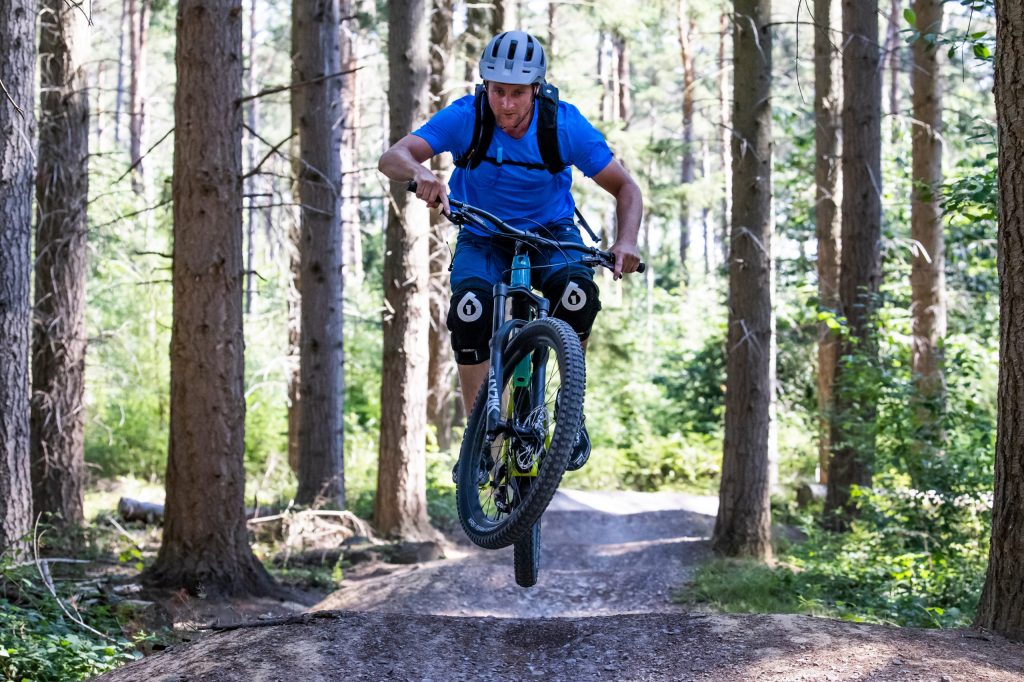
Autofocus brisk, plus Canon has made it easy to toggle between AF area modes with the small M-Fn button after using the AF point select button. Zone AF combined well with Servo AF to keep apace with cars and cyclists approaching the camera head-on. Only when I pulled back quickly from 200mm to 70mm did the camera misinterpret focus. I put this down to the subject moving outside my central Zone AF area. There’s the option to choose from two AF point sizes (pinpoint and normal). I’d like to see Canon introduce the ability to resize the AF point and the Zone AF area to your liking, much like Fujifilm and Panasonic offer.
Switching over to the wider horizontal and vertical Zone AF area modes can result in better success. Anyone wanting to track erratically moving subjects to the far edge of the frame can use the AF tracking mode. This gives continuous shooting at 20fps. You’ll also benefit from face and eye detection, which works exceptionally well in both One Shot and Servo modes.

The R5 is now more responsive at identifying people’s eyes and faces from greater distance than the EOS R. You can also prioritise which face or eye you’d like to focus on with the AF select button and joystick. Set the subject detection to animals and the camera accurately detects the faces and eyes of cats, dogs and birds as well as it does for people. I was particularly impressed by the way face detection picked out cricketers heads, even when they weren’t looking towards the camera.
As with other aspects of the EOS R5, firmware updates have enhanced the camera’s autofocus skills. V1.5.0 brought advanced recognition of fast-moving vehicles including the ability to lock onto a driver’s helmet if it is visible.
Another highlight of the EOS R5 is its ability to acquire focus in light levels as low as -6EV. In use, it locked onto and acquired accurate focus in poorly lit scenes with ease. You’ll value this if you’re regularly challenged by minimal ambient light.
Performance
It’s only by using a camera extensively that you find out any peculiarities it might have. The EOS R5 doesn’t have many quirks. Saying that, with the screen sensitive to light touches, it’s easy to inadvertently fire the shutter with touch shutter enabled. This became frustrating to the point I ended up disabling it. Reviewing and inspecting images at high magnification also needs the switch dial setting enabled in order to intuitively control the magnify/index view from the front top plate dial. I’m surprised Canon didn’t chose to have this set to enabled out of the box.
Reports note the camera generates excessive heat when the EOS R5 records high-resolution video. Naturally, findings will vary depending on the situation and conditions the camera is tested in. Recording full sensor width 8K Raw video internally to the card at 25fps in a room at 23°C from a cold start resulted in 17 minutes 21 seconds of continuous footage – just short of the specified 20 minutes. An overheat warning icon popped up onscreen after 14 minutes. The rear of the camera also became very warm to touch.
After leaving it to cool, I switched to full sensor width 4K 120p recording. It managed 4 minutes before the overheat icon reappeared and the camera shut itself down three minutes later due to overheating. Before recording starts, the camera displays an estimate of the recordable time based on the current camera temperature and the set recording mode.
It went on to record full sensor width 4K 60p footage for 29mins 59secs with no overheating, though expect to get ten minutes less if you select the APS-C crop (5.1K oversampled) setting. Recording full sensor width 4K 30P footage from a cold start didn’t reveal any overheating concerns.
Serious video users will be put off the EOS R5 by the irritating cool down-time between spells of recording. If you shoot short snippets of 8K and 4K video, you’ll get away with no cool down. However, any lengthy recordings do require you to wait, which isn’t always possible on set or during a never-to-be-repeated scenario. The time until the full record time is available again varies based on factors such as the selected shooting resolution, ambient temperature and continued camera operation. At 8K 30P, 20 minutes of cool down time gives users an extra 8 minutes of recording time, whereas at 4K 60P, 10 minutes cool down time gives another 10 minutes of record time.
Testing the IBIS system confirmed that it reliably stabilises handheld shots and video footage, but how slow you can attain sharp handheld shots is still very dependent on how steady your handheld technique is. I had no difficultly achieving sharp shots at shutter speeds as slow as 1/5sec using the RF 70-200mm F2.8L IS USM at full telephoto, and 2secs with the RF 15-35mm F2.8L IS USM at its widest point. If you’d like to shoot without IBIS you’ll need to turn stabilisation off directly from the lens. The third lens Canon sent with the camera was the optically stellar RF 24-70mm F2.8L IS USM, a lens that’ll allow you to shoot up to 8 stops slower than would otherwise be possible.
When I tested the camera with a SanDisk Extreme Pro 512GB CFexpress card capable of 1700MB/s read and 1400MB/s write speeds, it recorded 2851 raw files to the card at 12fps using the mechanical shutter before it hit the buffer. It recorded an unlimited number of files when I switched to the Large JPEG file format. In electronic shutter mode, the EOS R5 rattled off 62 uncompressed raw files (121 CRAW’s) at 20fps in electronic shutter mode before it reached its buffer.
This number increased to 130 frames when shooting Large JPEG images. I also managed to record 58 raws/JPEG files at 20fps before any sign of slowdown. Despite talk of some EOS R5’s overheating when shooting continuously, I experienced no such issue of this, not even when shooting sport for an afternoon in temperatures as hot as 34°C.
While the build up of heat impairs its video performance, the EOS R5’s performance as a stills camera is outstanding. You can’t fail to be impressed by its attractive images, faithful colour and the way it focuses and controls noise when you ask more of it in low light. The only area where DSLRs really still hold an advantage is battery life. With the EOS R5 being power hungry, especially when shooting high-resolution video or continuous bursts, users will want to carry a few spares, buy the BG-R10 battery grip ($349 / £379) or get into the habit of topping up power on the go via USB. You’ll need a power bank with a power delivery lead and at least 20W power output to charge the camera and 65W to charge and run the camera at the same time.
As previously mentioned, firmware v1.60 brought along the Auto Power Off Temperature option and selecting High means the camera can give longer video shooting times, depending on the ambient conditions.
Image Quality
If you’re curious to know more about the camera’s crop modes, there’s five settings in the menu that can be assigned to a custom button for instant access. As well as recording stunningly detailed 45MP (8192×5464 pixel) images, which equates to a 27x18in or 69x46cm print at a critically sharp 300ppi output resolution, there’s a 1.6x crop setting for those who’d like to gain greater reach from their lenses at a reduced 17MP (5088×3392 pixel) resolution. Other crop modes include 1:1 (5456×5456 pixel), 4:3 (7280×5464 pixel) and 16:9 (8192×4608 pixel), outputting 30MP, 40MP and 38MP files respectively.
Editing a few underexposed landscape raw files where I’d exposed for the sky to preserve highlight detail revealed that users can put a huge amount of faith in the camera’s dynamic range. The sensor offers remarkable leverage when recovering shadow detail, as the processed image of Beachy Head illustrates below.

As always, there isn’t as much leeway when it comes to recovering highlights from raw files. In high-contrast scenes, users may wish to take advantage of the new HEIF image format that boasts 10-bit colour for greater dynamic range and higher image quality than JPEG files, but outputs at approximately the same file size. It’s also possible to process HEIF files in-camera to produce JPEG files with a wider dynamic range than regular JPEGs.

The camera resolves astonishing detail in raw files, especially at high ISO. There’s also freedom to crop tightly into images whilst preserving high detail. Plus, the way it resolves such fine detail at ISO 12,800 and ISO 25,600 means they’re useable in low light with some noise reduction applied. Users will also be delighted by the way the sensor controls colour noise and preserves faithful colour and vivid saturation high into its ISO range. The EOS R5’s terrific image quality is backed up by an impeccable metering system that rarely misjudges a scene.
ISO and Noise
A key strength of the EOS R5 is the way it handles noise in its raw files at high sensitivity settings. You can expect clean, noise-free images between ISO 50 and ISO 800. Luminance noise does starts to appear at ISO 1600, however it’s only apparent when you examine images critically at 100% magnification. Noise is superbly controlled at ISO 3200 and ISO 6400 too, though both settings do benefit from a little noise reduction in post processing.
The detail the EOS R5 resolves at even higher settings is mightily impressive and I wouldn’t be reluctant to shoot as high as ISO 12,800 or ISO 25,600 when presented by extremely challenging lighting conditions. Fine detail is affected more noticeably at ISO 51,200 and ISO 102,400. What with there also being a green tinge and reduction in colour saturation at these highest two settings, it’s best to steer clear of them.
Verdict
Canon’s first premium full-frame mirrorless camera was a long time in the making. The EOS R5 probably arrived two years later than many would have liked, and Canon needed to pull out all the stops if it was to be successful at delivering what serious photographers and loyal users have been patiently waiting for.

As a stills camera, the EOS R5 is phenomenally impressive. The sensor and highly effective IBIS system deliver images of exquisite quality. It’s one of the finest mirrorless cameras to roll off Canon’s production line and though it is expensive, you get a dependable, hardwearing and wonderfully intuitive camera in return that overcomes the criticisms associated with the early EOS R. The combination of a multi-controller, dual card slots and a rear thumb dial is what EOS 5D-series owners expect from a camera they might well upgrade to.
Video shooters might find it overheats when filming lengthy 8K and 4K 120p video clips, but Canon openly admits this and hasn’t tried to sweep it under the rug. If you’re not one for shooting video, overheating is not a concern.
Photographers who buy the EOS R5 will be smitten with it. It does get through its battery power fairly quickly, but it’s incredibly versatile, capable of churning out superb high-resolution landscape shots as it is capturing high-speed action sequences at a blistering 20fps with continuous AF. It’s an ideal candidate for portrait, wedding and documentary photographers, too, with its improved face/eye detection, and good for anyone who insists on a higher resolution output than the EOS R6.
I fell in love with using the EOS R5, but dropping $3,399 / £3,799 on a camera body is hard to justify. Add two or three L-series RF-mount lenses to it and the price you’ll pay soars close to, or above, the £10k mark! It’s no wonder its EOS R6 and R6 Mark II siblings were so well-received by the masses. Especially when you consider how much they retain from the EOS R5 for considerably less money.
Ultimately, the EOS R5 was extremely close to picking up our highly acclaimed Gold Award, but falls just short of doing so. It’s a remarkably accomplished stills camera. But its susceptibility to overheating in high-resolution video, along with its high price, means it just misses a maximum 5-star rating.

See our guide to the best Canon mirrorless cameras, and the best Canon RF mount lenses.
Related reading:
- Canon EOS R5 vs Canon EOS 5D Mark IV – which is best?
- DSLR vs mirrorless: which is best?
- Canon EOS R50 in-depth review: ingenious but flawed
- Canon EOS R3 review

